World War I
 From Rationalwiki
From Rationalwiki 
| It never changes War |
| A view to kill |
v - t - e
|
“”
"The real reason for the whole thing was that it was too much effort not to have a war. You see, Baldrick, in order to prevent war in Europe, two superblocs developed: us, the French and the Russians on one side, and the Germans and Austro-Hungary on the other. The idea was to have two vast opposing armies, each acting as the other's deterrent. That way there could never be a war." |
| —Captain Blackadder (Rowan Atkinson |
World War I (usually abbreviated as WWI or WW1) was a global conflict that originated in Europe and lasted from 28 July 1914 to 11 November 1918. It is also known by its contemporary name, the Great War. Some idealists of the era infamously described it as "The War to End War",[2] but subsequent generations have realized that this was hopelessly naive.
World War I was one of the deadliest conflicts in human history, and saw about 8.5 million soldiers die from various causes[3] while the associated H1N1 pandemic (usually called the "Spanish Flu") killed another 50 million people.[4] The civilian death toll is difficult to determine due to the era's lack of record-keeping, as well as various other factors, such as the Spanish Flu, general starvation resulting from blockades, and concurrent genocides; however, the best estimates approximate 6 to 10 million civilians dead.[5]
This continental clusterfuck was brought about by the general failure of the post-Napoleonic world order to keep peace. The system of massive alliances, which should have served to deter any massive war, actually resulted in a regional conflict becoming a global one. The great powers of Europe had neatly divided themselves between two coalitions: the "Triple Entente," sometimes called the Allies, (consisting of France, Russia and the United Kingdom) and the "Triple Alliance," or Central Powers, (consisting of the German Empire, Austria-Hungary and the Italy, which ultimately sided with the Entente and was replaced by the Ottoman Empire). The failure of Germany's "Schlieffen Plan" in 1914 infamously saw the Western Front of the war stagnate into bloody, pointless trench warfare. Brutal combat also took place in Eastern Europe, the Middle East, Africa, and East Asia. Ultimately, the war became a test of which team would be too exhausted to continue, and the late intervention of the United States on behalf of the Entente helped finally end the war.
The war proved transformative to world history. The Sykes-Picot Agreement split the Middle East between the victorious Triple Entente — breaking promises made to their Arab allies, which permanently destabilized the region[6] and helped pave the way for the rise of the current Wahhabi terrorist regime of Saudi Arabia.[7] Social upheavals caused by the prolonged conflict helped usher in an ideology that saw violence as the beneficial and natural state of humanity. The devastation caused by the war birthed various totalitarian political manifestations, such as Vladimir Lenin's Soviet Union and Nazi Germany. Meanwhile, the 1919 Treaty of Versailles utterly failed to maintain peace past ending the war. Its provisions were light and shoddily enforced, and it was enough to radicalize the nations who were unhappy with the peace, but not enough to stop them from starting the party all over again.[8] Ultimately, while the end of World War I saw many nations liberated, they would all be forced to endure another, even worse war that would lead many of them to lose their sovereignty.
Why it happened[edit]
“”I consider a war inevitable—the sooner, the better.
|
| —Helmuth von Moltke, Chief of the Great German General Staff.\[9] |
In comparison to the relatively simple explanations for World War II, the historiography as to why World War I happened is hideously diverse.[10] However, most emphasize the rampant nationalism, imperialism and Social Darwinism bubbling throughout the whole continent (leading to an unstoppable arms race), with Germany, Austria-Hungary and Russia ultimately pushing things over the edge.[11]
Balance of power[edit]
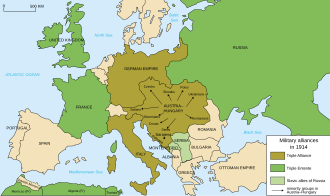
The political map of Europe looked very different 100 years ago, with far fewer countries than now — and most of Central and Eastern Europe controlled by large multi-ethnic empires. Many European countries — even small ones like the Netherlands and Belgium — operated colonial empires. Peace was, and had been since the end of the Napoleonic Wars, maintained through "balance of power theory". The idea here was that as long as every nation or alliance of nations was roughly equal in strength, no nation would seek a potentially ruinous conflict.[12] If one nation became significantly stronger than the rest, it was feared that it would take advantage of this strength and begin attacking its neighbors.
Although balance of power theory (mostly) kept the peace during the 19th century, even weathering the tumultuous Scramble for Africa, there were a number of challenges that eventually caused the theory to fail. From 1848 onward, the Kingdom of Prussia consolidated its hold over central Europe, defeated France in a brief war in 1870, and created a unified German Empire for the first time.[13] The rise of this behemoth was a shock to the European order, and much of the latter 19th century was defined by Germany's attempts to gain power and isolate France.
Meanwhile, the Ottoman Empire had entered the final phase of its prolonged, lingering death. The loss of its holdings in southern Europe led to the independence of the Balkan states: Serbia, Bulgaria, Greece, Montenegro, and Albania. Each of these nations had territorial claims on both the Ottoman Empire and each other, which resulted in the First and Second Balkan Wars.[14] The power vacuum in the region led the great powers to jockey for influence there,[15] worsening the situation and causing Bulgaria to break up with its historical pal Russia. Other unforeseen complications for the continental system were the United Kingdom's "splendid isolation" philosophy of foreign policy (where it refused to forge any lasting alliances)[16] and Kaiser Wilhelm II's firing of the brilliant Chancellor Bismarck and his subsequent alienation of Russia.[17]
Nationalism and xenophobia[edit]

“”How sweet and honourable it is to die for one's country.
|
| —An old saying later denounced as a lie by veteran poet Wilfred Owen[18] |
It's pretty much impossible to have quality discussion about World War I without an acknowledgement of nationalism as its foundational cause. During the 19th and early 20th centuries, most citizens of the great European powers had convinced themselves that they lived in the apex of cultural, economic and military supremacy. Historian Lawrence Rosenthal describes the mood of the era as "a new and aggressive nationalism, different from its predecessors, engaged the fierce us-them group emotions – loyalty inwards, aggression outwards – that characterise human relations at simpler sociological levels, like the family or the tribe."[19] Nationalists overestimated the strengths of their own nation while becoming simultaneously convinced of the weakness and scheming of their neighboring countries. The origins of European nationalism were myriad; it was the byproduct of imperialist expansion, but it was also encouraged by elites to ensure loyalty.[19]
In this kind of environment, it was probably inevitable that Europeans started to consider war a necessity and a good thing. An adventurous opportunity to die for one's country was an attractive idea to European militarists, especially if it helped spread the ideals of self-sacrifice, discipline, and obedience.[20] Karl Pearson, a British proponent of eugenics,[21] expressed this view by writing that nations need to maintain their position in the world "by contest, chiefly by way of war with inferior races, and with equal races by the struggle for trade routes and for the sources of raw materials and food supply."[22]
Thus, when the war came, many people across Europe were thrilled by it. The old veterans remembered their glory in the relatively brief wars of the post-Napoleonic order and lived as the most prestigious members of society, while teachers and governments encouraged young men to sign up to serve their countries in a grand old adventure.[23]
Racism[edit]

Racism was a major (but mostly ignored) source of the hatreds that exploded into war. After all, you have to remember that this was the era of eugenics and human zoos. French intellectuals loved to portray the Germans as an inferior culture and race, claiming that the Germans' bad smell made Frenchmen in Alsace-Lorraine miserable and that "barbarism" was an inherent quality of the German race.[24] The French also tied some aspects of German culture to the Africans they scorned so much, like claiming that the German spiked helms were reminiscent of the "half-savage tribes of Central Africa".[25] The Germans, meanwhile, considered all Slavic races to be their natural yet inferior enemies.[26]
Social Darwinism also played its part, convincing European leaders that they needed to overcome their racial enemies in a victorious struggle for resources if their nations were to survive.[27] Under Social Darwinist ideas, diplomacy and peace were pointless, simply risking national survival for the sake of reasoning with an inherently unreasonable enemy.
Naturally, Europe's colonial possessions and the recent race for African colonies played the biggest role in injecting racism into the continent's people. There was more than just a philosophical impact, though. All European powers, especially France, enthusiastically exploited their colonies for resources, labor forces, and even soldiers.[28] Europeans appreciated that black soldiers fought for them, but they considered them to be "naturally warlike" and too stupid to be worthy of promotions or rewards.[24]
Militarism[edit]

Following the successful Prussian model of "an army with a state", the monarchies of Europe shifted their priorities and internal structures in order to become more powerful militarily. This resulted in an atmosphere where many of Europe's politics were dominated by military figures, who were themselves lionized by state press.[29] Press and public opinion also increasingly viewed foreign nations as either targets or threats, and denounced them all accordingly. Politics and military power became intrinsically linked in the same way politics and economics are linked in our modern world. While militarism didn't start the war, it created a climate where much of Europe's population saw war as a more effective means of resolving disputes than diplomacy. Surrender and the corresponding hit to national pride was unthinkable.
A specific crisis brought about by militarization was the Anglo-German naval arms race. In the 19th century, naval power was seen as a direct measure of a nation's overall strength. German Admiral Alfred von Tirpitz, with the approval of Kaiser Wilhelm II, began a massive naval buildup for the German Empire, designed to compete with the British Empire and establish Germany as a world-class power.[30] The British responded with a feverish buildup of their own. This naval arms race further added to the atmosphere of fear and distrust in Europe, and helped push the British into siding with the French against the Germans.
The legacy of the naval arms race loomed large over postwar geopolitics as well. It resulted in the London Naval Conference, which limited naval tonnage among the great naval powers in order to prevent another arms race.[31]
Path to war[edit]

Forging the alliances[edit]
Facing French hostility after the Franco-Prussian war, Chancellor Otto von Bismarck sought a network of alliances that would deter the French from attacking. Thus, even after fighting a war against Austria during the 1860s, Bismarck successfully negotiated the Dual Alliance with them, giving Germany its first-ever friend on the international stage.[32] In 1882, this grew into the Triple Alliance with the addition of Italy, but this bloc was permanently unstable due to Italy's territorial claims against the Austrians.[33] Nonetheless, the alliance had the outward appearance of strength, and that's what counted.
In 1904, the colonial competition between Germany and France made its way to Morocco, where Germany fought to keep the Amazigh nation independent just to fuck with France. Ultimately, Germany extracted some small concessions from France in the region, but the Morocco Crisis only really served to begin pushing the British towards friendship with France.[34] That same year, the United Kingdom and France signed the "Entente Cordiale", an agreement of French support for British colonialism in Egypt and British support for French colonialism in Morocco.[35] Despite being a relatively minor agreement, the Entente Cordiale was motivated by mutual suspicion toward Kaiser Wilhelm II's increasingly dangerous foreign policy, and ended nearly a thousand years of almost constant Anglo-French hostility. This agreement, along with France's longstanding alliance with Russia, evolved into the "Triple Entente" as the three nations sought to counterbalance Germany's (seemingly) powerful Triple Alliance.[36]
The Bosnian Crisis[edit]
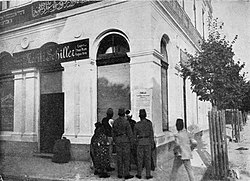
The most direct seeds of the coming storm were laid in 1908 in the Balkans. Back in 1878, the Congress of Berlin had been called among the great powers to address the ongoing decline of the Ottoman Empire, and one of its provisions allowed Austria-Hungary to occupy and administer the Ottoman province of Bosnia.[37] The Hapsburgs spent the next decades building their administration in the region and investing in its infrastructure. In 1908, Austria-Hungary formally announced that it was annexing Bosnia, partially to expand its own holdings but also to guard against the southern Slavs of the Balkans.[38]
The annexation sparked immediate outrage in Serbia, as its citizens were nationalists who wanted to reunite with the ethnic Serbs who lived in Bosnia. Although Russia had previously agreed to the annexation, the angry public reaction there forced the government to demand that Austria cede a portion of Bosnia to Serbia.[37] Austria threatened war over the issue, backed up by its ally Germany, and Russia backed down.
While the issue was resolved without warfare, it enraged and humiliated Russia and ensured that it would no longer back down from a threat of war. The people of Serbia were also angry with Austria, and the harsh feelings on both sides would eventually result in the event that kicked off the war.
Getting the party started[edit]
“”The next great European war will begin over some damned foolish thing in the Balkans.
|
| —Otto von Bismarck, 1888[39] |
Assassination of Archduke Franz Ferdinand[edit]
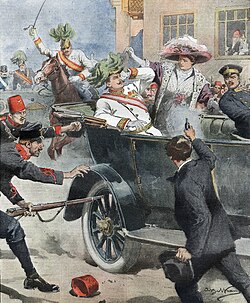
Things went pear-shaped after the assassination of the heir to the throne of Austria-Hungary, Franz Ferdinand, in Sarajevo (the capital of Bosnia) on 28 June 1914. Ferdinand was visiting the city in conjunction with Austrian troop exercises there.[40] Austria and Serbia had spent the years after the annexation of Bosnia grappling for diplomatic and economic control over the Balkans. Austria placed a German prince in charge of Albania to block Serbia's access to the sea, but Serbia responded by forming a customs union with Montenegro.[41] So it went, with hatreds between the two nations increasing in intensity.
Just before the visit, a group of radical young Bosnian Serbs received word of the Archduke's arrival and decided it must be an insult to the Serbs, as his visit fell near the anniversary of a historic Serbian defeat.[41] Among them was Gavrilo Princip, and they were all members of "Young Bosnia", a political activist group that sought the creation of a Serb-led Yugoslav nation.[42] Also involved in the plan was the Black Hand, a terrorist group run by Serbian nationalists that also sought the unification of all ethnic Serbs.[43]
Driving in a car amidst low security and an enthusiastically supportive populace, the Archduke was suddenly attacked by one of the conspirators, who failed to kill him with a bomb.[44] Sarajevo's mayor, who was unaware someone had just chucked a bomb at his guest, began delivering a speech to the horrified Archduke, who remarked, "Lord Mayor, what is the good of your speeches? I come to Sarajevo on a friendly visit and someone throws a bomb at me. This is outrageous!"[44] Ferdinand eventually regained his composure while continuing his tour of the city, and even started joking about the incident, but he and his wife were then shot in his car by Gavrilo Princip after his convoy took a wrong turn onto the street right in front of the assassin.[44]
Ferdinand's death made surprisingly little impact in Austria; as one historian remarked, "The event almost failed to make any impression whatsoever. On Sunday and Monday (the day of and the day after), the crowds in Vienna listened to music and drank wine as if nothing had happened."[45] In Sarajevo, however, the Austrian government encouraged an anti-Serb pogrom that caused two deaths and the destruction of much property.[46]
The July Crisis[edit]
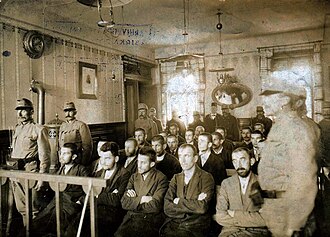
“”The First World War was a tragic and unnecessary conflict. Unnecessary because the train of events that led to its outbreak might have been broken at any point during the five weeks of crisis that preceded the first clash of arms, had prudence or common goodwill found a voice.
|
| —John Keegan, English military historian[47]:3 |
The assassination set off a chain reaction of diplomatic maneuvering among the great powers that continued throughout July 1914. While the Serbian prime minister was initially conciliatory, Austria discovered by interrogating the captured conspirators that multiple officials in the Serbian government had been involved in the plot.[48] Even before ascertaining for certain that Serbia was responsible, Austrian military officials had decided on war against Serbia, reasoning that it had been a thorn in their side for far too long and that a quick little war would settle accounts for good. The Germans agreed to back the Austrians in whatever action they decided to take, also reasoning that Balkan peace could only be achieved through Serbia's destruction.[49] The Germans also expected the Austrians to strike rapidly before any of the other great powers could set their own plans into motion, thus keeping the war a limited affair. Instead, the Austrians hesitated.
Fearing an immediate attack would provoke the Russians, the Austrians decided to use diplomacy to manufacture a casus belli. This led to the creation of the "ultimatum plan" where Austria would deliver an intentionally harsh set of terms and then attack once Serbia had refused. The Austrians and Germans tried to reason that the Russians would not come to Serbia's rescue if given enough reason to stay put. All of their assumptions to this end were wrong. The Tsar decided that his nation was ready enough for war with the West, while he also sought to be more aggressive in foreign affairs both due to France's urgings and the still-recent memory of his embarrassing cave during the Bosnian Crisis.[50]
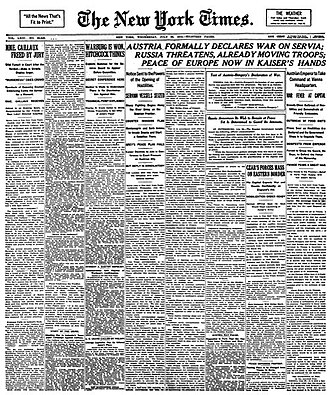
Serbia ended up agreeing to nine of Austria's eleven demands, including that they censor anti-Austrian publications and crack down on Serbian nationalist groups working against Austria.[51] The Germans, meanwhile, set about trying to convince France and the UK to stay out of it. However, their diplomats used intentionally soft language to describe Germany's plans, fooling the French and British into thinking that the Germans also hoped to keep the peace in the Balkans.[51] The British and French thus replied with ambiguous statements that the Germans interpreted as meaning that they would not aid Russia and Serbia. This was a fatal miscalculation on all sides.
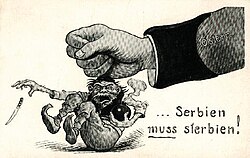
Austria rejected Serbia's response (as they were always planning to) and started mobilizing for war on 25 July.[51] This time, the Russian diplomats fucked up. They denied that Russia was mobilizing against Austria, hoping to defuse the situation.[51] Instead, that news only encouraged the Germans and Austrians that war would be easy and limited. In reality, the Germans and Austrians had, through their own trickery and double-dealing, falsely convinced themselves that Russia, Britain and France would not try to bail out Serbia, which was far from the case. The Russians were intent on not backing down, and wanted to save their only ally in the Balkans. The French were perfectly happy to come to the aid of Russia, and still hoped for a chance to avenge their loss in the Franco-Prussian War. The British, meanwhile, had been taught a harsh lesson by Napoleon in what happens when they allow matters in Europe to spiral out of control. Thus, all three members of the Triple Entente were ready for war.
Austria declared war on Serbia on 28 July. Germany immediately backed them, and it became apparent that the Germans' talk of trying to keep the peace and restrain its ally had all been a sham to intentionally muddy the waters. Germany had never intended to stop the war; it only hoped to sow enough doubt to stop the other great powers from intervening. The German ambassador to Russia recounted that the Russian Foreign Minister "now saw through our whole deceitful policy, he no longer doubted that we had known the Austro-Hungarian plans and that it was all a well-laid scheme between us and the Vienna Cabinet."[52]
The dominoes quickly fell into place after that, as each of the great powers honored their alliances and joined the war.
The war[edit]
“”The lamps are going out all over Europe, we shall not see them lit again in our life-time.
|
| —British Foreign Secretary Sir Edward Grey, 3 August 1914[53] |
Opening hostilities[edit]
Invasion of Serbia[edit]

The Central Powers opened the carnage with a disjointed, contradictory series of offensives that set out the basic pattern of pretty much the entire German/Austrian coordination (or lack thereof) that would last until Austria-Hungary had been so worn down that it would basically become a German satellite in constant need of propping up during the later stages of the war.
Germany's plan was ambitious but fairly straightforward: hit France with most of their army (more on that later) while Austria held off the Russian hordes in a delaying effort until the expected victorious German forces could be shifted from west to east. Austria, on the other hand, assumed that Germany would hold off the Russians while they swept in and crushed Serbia.[54] Austria-Hungary, and especially its supreme commander, Conrad Von Hötzendorf, vacillated between a vengeful strike at Serbia (i.e. the limited war of punishment they wanted) and a great power war with Russia (i.e. the war they actually faced).
The Austro-Hungarian ambiguity and indecisiveness led to some rather farcical shifting of troops back and forth between the Serbian and Russian fronts that mainly resulted in tiring out the Austrian-Hungarian soldiers before the fighting had even started, including having them march distances in the sweltering late summer heat that they could easily have covered by train (due to misplaced fears of a rapid Russian cavalry strike against the forward railheads). The other main result was to ensure that the Serbian front would not see a strong, all-out offensive while the defence on the Russian front would be weakened as well. One reason was a derisive attitude towards the Serbs, leading to a belief that Serbia would be quickly defeated, even by a weakened offensive; the other was unrealistic optimism about the ability of the weakened Austro-Hungarian defence in Galicia to hold off the Russians until the Germans had won in the west.
While the Austrians were under-strength, the Serbians placed their army under the command of the capable Radomir Putnik, a veteran of the turbulent Balkan Wars. Putnik took advantage of Serbia's mountains and rivers to rout the Austrians twice, resulting in the failure of Austria's invasion.[55] Serbia's defeat of Austria in 1914 has been called one of the greatest unexpected victories of the entire 20th century,[56] and was the first great wrench thrown into the Central Powers' plans.
The Schlieffen Plan[edit]

German leaders were quite aware that they were in danger of being caught in a two-front war between France and Russia. Their plan to avoid this had been proposed by Alfred von Schlieffen, chief of the German general staff, in 1905,[57] and called for a rapid, overwhelming attack to defeat France while token forces held the line against Russia. Once France was out of the picture, the Germans could turn east. Instead of invading across the German-French border, the Germans would advance through Belgium and turn south to catch France by surprise and capture Paris, forcing them to make peace.[58] With the benefit of hindsight, it's now apparent that Russia was the softer target due to its lack of industry and fragile political situation. The German general staff, however, had a healthy respect for Russia's size and manpower, and they had easily defeated France in 1870.
Almost ten years after the creation of the Schlieffen Plan, it fell on Helmuth von Moltke to revise it for a more modern war; however, he was not up to the task. Moltke allowed the units on the French border to attack, then took manpower from the crucial invasion force against Belgium to strengthen it.[59] Moltke then robbed the western forces of even more strength to defend East Prussia from a faster-than-expected assault by the Russians. The final result was that the invasion force against Belgium and northern France was weaker than it should have been.
Invasion of Belgium[edit]
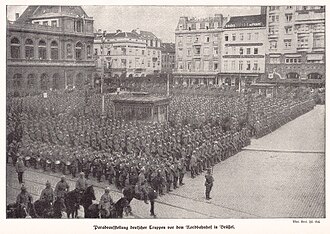
The Germans invaded Belgium in August 1914, despite the fact that Belgium had been a recognized neutral country for most of a century. Not expecting a real fight, German soldiers marched parade ground-style towards the Belgian positions, only to be cut down by machine gun fire.[60] Despite the initial fuckups, the Germans managed to take Brussels by 20 August.[61]
.jpg)
German soldiers acted with brutality against Belgian civilians during the occupation, shooting civilians, burning villages, and murdering priests.[62] The Germans were frustrated by the determined Belgian resistance, and often took it out on the normal people of Belgium, sometimes after baselessly accusing them of being covert snipers.[63] It's estimated that about 6,000 Belgians were murdered outright, while over 17,000 died during the subsequent occupation, now called the "Rape of Belgium".[64] Fearing that the Belgian civilians escaping into the Netherlands could be spies, the Germans built and guarded a 2,000-volt electric fence complex across the border, which is estimated to have led to the deaths of at least 1,000 people.[65] The Belgian economy was further destroyed as the Germans looted industrial equipment and later began using Belgian civilians as forced labour.[66]
The usual narrative is that the British joined the fray to protect Belgian neutrality, but that's only part of the story. In reality, Prime Minister Herbert Asquith and Foreign Secretary Edward Grey had decided even before then, and without Parliament's knowledge, that Britain was going to intervene against Germany at some point.[67] Grey actually pledged naval assistance to France two days before the invasion of Belgium, which infuriated the pro-neutrality members of Cabinet and caused no less than four of them to resign.[67] However, the German invasion of Belgium did play an important role in the war; the British, while resolved against Germany, were sort of divided about war, with the Liberal party in particular squeamish about it. What happens when a country halfheartedly fights a war is well-known. Belgium played the part of decisively resolving Britain in favour of war. For instance, Lloyd George said, "Up until last Sunday only two members of the Cabinet had been in favour of our intervention in the war, but the violation of Belgian territory had completely altered the situation."[68]
Japan joins the war[edit]
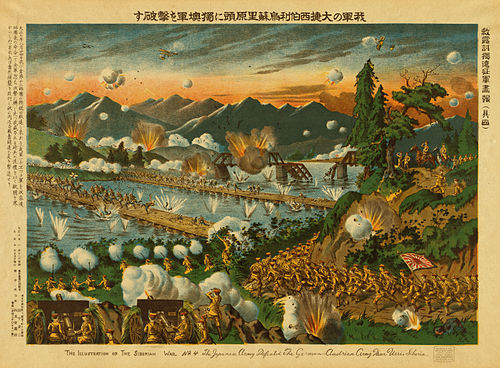
Meanwhile, on the other side of the globe, Japan had been the United Kingdom's sole ally since 1902.[69] With the Brits having joined the effort against Germany, Japan proposed that it join the war and use the opportunity to seize Germany's Pacific island colonies.[70] With apparent agreement all around, Japan declared war on Germany in August 1914.
Japan, however, was not about to waste the opportunities that a nice little war presented. Japan first tried to threaten Germany into relinquishing one of its ports in China, then began focusing attacks on all of Germany's Chinese outposts.[71] Japanese officers very quickly figured out the pattern that successful ground warfare would take in this conflict. The German port of Qingdao in China's Shandong province became the proving ground for their new tactics. First, Japan blockaded Qingdao with its navy, then surrounded the area on land to begin bombarding the city with artillery and warships.[71] Shelling continued for about a month until the Japanese figured that German supplies had run low enough to make an actual attack safe. Qingdao fell to Japan in early November 1914.[72]
This victory gave Japan another opportunity in China. In January 1915, Japan issued to China the "21 Demands", ordering the Chinese government to recognize Japan's ownership of the former German concessions, and to grant Japan special economic privileges in China.[73] The timing was genius. Japanese troops were already on Chinese soil in perfect position to threaten, and none of the Western powers could object, since they were either fighting alongside Japan or already at war with Japan.
The Japanese navy also set about expanding the Pacific conflict against Germany by picking off Germany's islands. Control of Pacific islands had long been a key objective for Japanese war planners, as they had already identified the United States as their key rival for influence in the Pacific, and these islands would prove to be useful naval outposts in the event of conflict.[71]
Hindenburg and the Eastern Front[edit]
.jpg)
While trashing Belgium and advancing into France, Germany realized it had made a disastrous strategic mistake. They expected that Russia's huge size and low level of development would mean a lengthy mobilization time, therefore allowing Germany to defend its eastern border with only one army.[74] Imagine their surprise when they received word that the Russians had already breached their borders in the summer of 1914. German military leaders hastily redeployed two divisions to the Eastern Front in order to stave off a complete disaster.
With Paul von Hindenburg in command of German forces on the Eastern Front, Germany halted the Russian advance into East Prussia during the first month of the war with the Battle of Allenstein. The victory was made possible by the Germans' rapid maneuvering skills, as well as the Russians' failure to encrypt their messages.[75] The end result was the Russian Second Army being completely crushed.
This first great victory over the previously dreaded Russians greatly improved German morale. The event was immediately mythologized by German propagandists, even though it wasn't even close to being a decisive action. While it allowed the Germans to go on the offensive, the Russians would not be expelled from German soil until the First Battle of the Masurian Lakes several months later.[76] However, Hindenburg declared that the Battle of Allenstein would henceforth be known as the Battle of Tannenberg, the idea being that the Germans had avenged the historic defeat of the Teutonic Order at the hands of Poland and other Slavic peoples during the 1410 Battle of Tannenberg.[77] The 1914 Tannenberg became a great propaganda tool for the Germans to use to bolster their troops' morale. Many Russians, on the other hand, became convinced that defeat was on the way and that they were only dying for the benefit of other countries.[74] This darkening of outlook helped contribute to later events.
After mauling the Russians at the First Battle of the Masurian Lakes, Germany fully went on the offensive. In 1915, what was intended to be a limited strike towards Russia's Polish territories resulted in a complete breakthrough into the region and Germany's advance far into Russia.[78] While these victories were great, Moltke had pulled troops from the Western Front, some of whom even arrived too late to have a significant impact at Tannenberg.[59] Their absence arguably contributed to Germany's later failure to take Paris.
Settling down for the long haul[edit]

Strategic situation in Europe after Germany's victory at Tannenberg and France's stabilization of the Western Front
Trench warfare begins[edit]
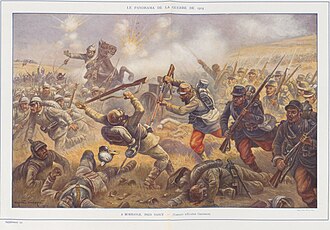
The Germans entered northern France successfully after crushing stubborn resistance across most of Belgium, but the speed of their advance strained their troops and stretched their supplies.[79] Not expecting the Germans to commit such a huge force to the invasion through Belgium, the French and British suffered key early defeats as they were forced to hastily reposition away from the German border and towards the new threat from the Belgian one.[80] The French were nearly encircled in the north, only being saved by General Charles Lanrezac's decision to withdraw from the front. This proved unpopular with the jingoistic and offensively-minded French high command, which promptly fired him for doing the right thing.[81]
France's obsession with offense also landed them into trouble on the actual border with Germany. Hoping to avenge their historic loss of the Alsace-Lorraine region in 1870, the French attacked there at the outset of the war. The Germans initially fell back, but this was merely the prelude to a devastating counteroffensive that saw the French pointlessly pouring men into German machine guns and artillery.[82] Soldiers who would have been valuable defending the north instead died in a fruitless attack on German soil. Nice one.
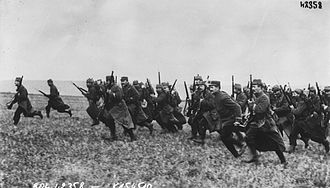
Despite the setback in Alsace-Lorraine, events started to proceed in the Entente's favor. Instead of sticking to their original plan, the Germans started to push back in Lorraine, ending up on the opposite end of the "throwing guys into machine guns" equation.[83] This led the battle to stalemate, freeing up many French troops to withdraw and help defend Paris.
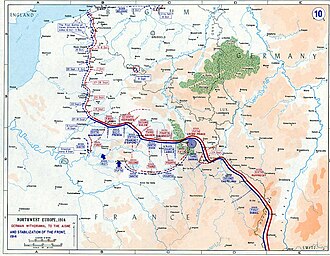
The Germans ran into further problems as their advance into France was weakened by the need to pull divisions and send them east to deal with the Russians, who had attacked far more aggressively than anticipated.[84] The French had also demolished bridges and torn up railroads ahead of the German advance, causing havoc to German logistics.[84] (Logistics would be a recurring problem for the Germans during the world war era).
After retreating for more than a week, the French and British were able to set up behind the River Marne outside of Paris to make their stand in defense of the French capital. Instead of defending, however, the French decided to attack the exhausted and overextended Germans, a decision which paid off in causing confusion and disarray in the German lines.[85] Caught with their pants down, the Germans had no choice but to fall back from Paris; the Schlieffen Plan had failed.
Victory on the Marne cost the French dearly, as they suffered a horrendous 250,000 dead or wounded and only inflicted around the same number on the Germans.[85] The Germans then took a stand behind the River Aisne while the Entente tried to attack them. This time, the Germans benefited from using defensive tactics, sheltering in trenches and using artillery to bleed the French and British of lives.[86] This was the first horrific taste of what the Western Front was to become.
With trench warfare quickly setting in, both sides tried to outflank each other during the so-called "Race to the Sea", realizing that direct assaults on trenches wouldn't go well.[87] These maneuvers were unsuccessful on both sides, as they were forced to stop when they hit the sea. This left everybody sort of staring at each other over a line of fortifications. You know where this is going.
Indeed, the advent of the machine gun and modern artillery meant that attacking an enemy formation with conventional 19th century tactics (like everybody had been doing) was tantamount to suicide. Soldiers dug into the ground for safety against each other's deadly firepower, and this rapidly developed into the infamous system of trench warfare across the entire front.[88] By October 1914, none of the armies were able to make any meaningful advances. By the end of the year, about 475 miles of trenches had been built across the entire length of the Western Front.[89] The famous Christmas truce occurred during 1914, but don't feel too good about Christianity just yet, because it ended immediately after Christmas Day and never happened again.[90]
The Ottomans join the war[edit]
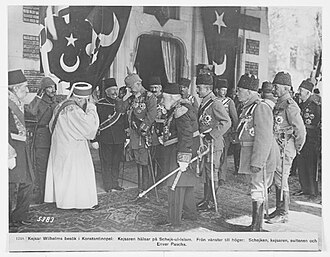
The Ottoman Empire had suffered a coup by military officers in 1908, and was dominated by War Minister Enver Pasha when the war began.[91] Pasha hoped to reconquer the Caucasus, which had been taken by the Russian Empire, a feat which could only be accomplished with help from Russia's other enemies. For his part, Kaiser Wilhelm believed that the influence of the Ottoman sultan in his position as caliph and custodian of the Two Holy Mosques could inspire colonial uprisings against the British and French from their Muslim subjects.[92] These shared interests evolved into a crazy plan for joint world domination: namely that Germany would conquer Europe while the Ottoman Empire incited an Islamic revolution across colonies in the Middle East and take the world's Muslims under its leadership.[93] The father of this plan, German Orientalist Max Freiherr von Oppenheim, was far more optimistic than his Turkish allies, who went along with it but didn't expect too much success.[94]
This shared dream tied the German and Ottoman empires together. While the Germans used Deutsche Bank funds to build railways across the Ottoman-ruled Middle East, the Turks allowed German archaeologists to ship the region's priceless ancient artifacts to Berlin's Museum Island.[95] These collections still exist at Berlin's Pergamon Museum to this day.[96]

The seeds of Ottoman intervention were laid shortly after the outbreak of the war, when the Ottomans signed an agreement with Germany exchanging military access through their lands for German assistance in modernizing their military.[97] Another secret pact soon followed, in which the Ottomans promised to help Germany in the event that Russia were to go to war with them. Meanwhile, the British alienated the Ottomans by stealing requisitioning two battleships that the Ottomans had bought from British shipyards.[98] Increasing Ottoman cooperation with Germany led the British to blockade the Ottomans.
The Ottomans finally entered the war in late October 1914 by launching a surprise bombardment against Russia's major ports on the Black Sea, using the pretense of a naval exercise to get their ships into position.[99] This overt act of hostility was done without a formal declaration of war, which the Ottomans only got around to in mid-November.
As the Ottomans declared war, the really interesting part of this story came into play. In accordance with what Turkey had planned with Germany, the Shaykh-ul Islam, the supreme religious authority in the Ottoman Empire,[100] issued a fatwa demanding that Muslims around the world take up arms against the enemies of the Ottoman Empire as part of a global jihad.[94] The proclamation also forbade Muslims from making war against Germany or its allies (which amusingly included Italy at the time). The jihad fell pretty flat due to the Ottoman Empire's losses early in the war, but the Germans immediately set up a propaganda office to produce material encouraging Muslims to join the jihad and rise up against Britain and France.[94]
Ottoman participation in the war successfully diverted much of the Entente's efforts. The Russians immediately launched an attack against the Ottoman Empire through the Caucasus, which ended in failure due to a determined Turkish counterattack.[101] Meanwhile, the British used troops pulled from their colony in India to launch an invasion of southern Iraq.[102]
Opening gambits at sea[edit]
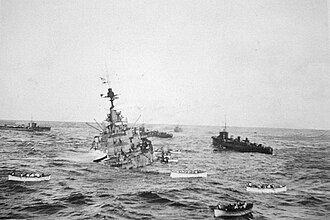
From late 1914 onward, the British Royal Navy blockaded the entrances to the English Channel and the North Sea, hoping to win the war through economic strangulation.[103] The impacts on the Central Powers were immediate, and civilians started to suffer food shortages as early as 1916. Germany also lacked the resources to make cordite for shells, and the blockade only exacerbated the situation.[104] Germany was not alone in its industrial suffering; France had lost much of its industrial heartland to the German advance, and the British also had trouble manufacturing shells.

British tactics during the blockade violated international law. For example, the British placed mines in international waters, which threatened neutral shipping.[105] The British blockade also considered harmless cargo such as food and medicine to be "contraband of war", a move the Germans rightly saw as a bloodthirsty attempt to starve their entire population into submission. Since there was no great international outcry over this, Germany anticipated that there would similarly be no great consequences for its later policy of "unrestricted submarine warfare".[106]
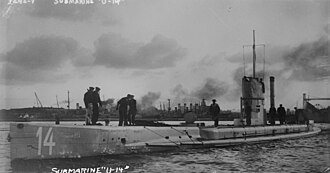
Both the British and the Germans envisioned that the naval war would unfold according to the views of United States officer and historian Alfred Thayer Mahan. In his essays, he argued that modern naval warfare should focus on the "grand battle" in which two opposing fleets would use heavy battleships to beat each other into submission until one side was knocked out of the war.[107] This never came to pass, since the British made some late alterations to their strategy and settled on a far-off blockade of the North Sea, meaning that their ships were too far away for the Germans to safely reach. Frustrated by their forced inaction, the Germans tossed out their old rulebook, too. They tried sending their navy to bombard British coastal towns to goad the Royal Navy into facing them, killing 137 people across the towns of Scarborough, Hartlepool and Whitby.[108] When that didn't work, the Germans turned to their U-boats.
Submarines had been a thing for about a decade by this point, and international Prize Law mandated that submarine crews had to warn merchant ships before firing upon them and then stick around to rescue the civilians.[109] In February 1915, the Germans said, "Fuck it, no more Mr. Nice Guy," and declared that they would sink all enemy shipping around the British Isles without warning, in flagrant violation of international law. Unfortunately, this policy was quite effective, as the British had no real counter to this. The Germans could sink approximately two ships a day, despite only having 30 operational U-boats.[109]
British shipping defended itself by flying the flags of neutral countries, which led Germany to declare its policy of allowing its submarines to sink neutral shipping. Foreign reaction to German unrestricted warfare was very negative, especially after the Germans sank the RMS Lusitania, (which seemed to be) a passenger ship.[110] Anger from the United States convinced Germany to cut it out for the time being, but the Germans had already seen how successful an undersea campaign could be.
Africa as a battlefield[edit]

“”It was... a campaign of supreme ruthlessness where a small, well-trained force extorted supplies from civilians to whom it felt no responsibility.... It was the climax of Africa's exploitation: its use as a mere battlefield.
|
| —John Iliffe, British historian, describing German tactics in East Africa[111][112] |
With the Scramble for Africa having taken place in the late 19th century, most of the European combatants also occupied large amounts of territory in Africa. African goods, labor and markets provided a great boost to the imperial powers' economies, and African coastlines provided space for so-called "coaling stations", which were necessary to refuel ships and extend the range of any country's navy.[113] These considerations convinced all of the European powers that African land was definitely worth killing each other over. As for the Africans? Well, from their perspective, one group of foreign occupiers simply replaced another. So it goes.
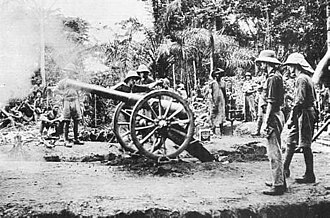
Most of the African Theatre resolved fairly quickly. Germany was a major power, but it had entered the world stage fairly late and thus was only able to make it out of the 19th century with four African colonies: the Togoland, encompassing modern-day Togo and part of Ghana,[114] Kamerun, encompassing modern Cameroon along with parts of the Congo,[115] German East Africa, which encompassed modern Burundi, Rwanda and Tanzania,[116] and finally, German South West Africa, which is today Namibia.[117] Meanwhile, the British and French controlled almost the entire rest of the African continent between them.

Surrounded by much larger enemy colonies, the Togoland was overrun in just three weeks by British and French forces.[118] The German commander there had been forced to abandon the colony's capital and fight a delaying action in the wilderness, but this proved futile.
The Entente had a much harder time dealing with Kamerun. The colony's size gave the Germans room to move around while the tropical south and mountainous north created natural defenses against any outside invasion.[119] Initially, the Entente benefited from the horribly racist way the Germans treated their African subjects. They took Kamerun's principal port with no objection from the natives, who had long been angry at the Germans' land expropriation policies.[119] The Germans abandoned the port and holed up in the colony's interior, aided by more loyal African natives. French and Belgian forces were able to seize much of the colony, but the German commander secluded himself in an impregnable mountain fortress called Moraberg (pausing to exchange Christmas gifts with his British opposite number).[120] Entente operations against the fort were forced to halt due to Kamerun's rainy season, but they managed to overrun the fort in early 1916. The campaign caused serious hardship for Africans in the region, as colonial recruitment and warfare led to shortages of food and basic commodities and waves of refugees.[120]

The campaign against German South West Africa was even more complicated. Due to geography, the British decided to largely rely on their colonial dominion South Africa to conduct the invasion. Unfortunately for them, South Africa was split between white British colonials and the horribly racist white Boers, who had been conquered in the Boer War and favored their German cousins. When South Africa's government agreed to fight against Germany, about 12,000 Boers rose up in violent protest of the decision.[121] This turned into an outright civil war between South African whites, as the Boers used guerrilla tactics to evade British troops. Although the rebellion was fairly quickly put down, it became a rallying cry for Boer nationalism that lasted for decades, contributing to the rise of the Boer-led National Party.[121] The National Party would much later go on to dominate South African politics and implement the apartheid regime.[122]
Despite the internal problems, South Africa eventually managed to successfully take over German South West Africa. East Africa, the last of Germany's colonies, managed to resist for the entire duration of the war under the leadership of Paul von Lettow-Vorbeck, later known as the "Lion of Africa". Determined to tie down as many Entente troops as he could, Lettow-Vorbeck used a tiny army of 14,000 men to fight off huge numbers of British and Indian soldiers by launching raids and using guerrilla tactics.[116] Unfortunately, the campaign had a dire impact on the people of East Africa. As colonial forces conscripted African soldiers and requisitioned crops, famine struck the region in 1917 and killed somewhere around 300,000 people.[123]
Trouble in the Suez[edit]

The entry of the Ottoman Empire saw the war expand throughout the Middle East. Much of the United Kingdom's military and economic strength came from India, so German and Ottoman planners naturally wanted to put that to an end. Their method was to seize the Suez Canal, which cut the Sinai peninsula and allowed for naval travel between the Mediterranean and the Red Sea, and therefore the world east of Africa. The British had controlled the Suez region and all of Egypt since the 1880s, and the waterway was the route by which the UK imported the raw material for its factories.[124] As the kaiser noted, cutting the Suez would be like cutting the British Empire's jugular vein.[124]
To this end, the Ottomans put together a 25,000 man-expeditionary force to attack the canal.[125] Since it was obvious that the Ottomans would make an attempt on the canal at some point, the British hastily mustered 30,000 troops from India in response.
On top of that, the British placed all of Egypt under martial law, turning the country into a giant military base. Over the course of the conflict, the British forcibly conscripted about a million Egyptians, often neglecting the draftees and forcing them to man posts in the desert with no supplies or medical assistance.[126]
Unfortunately for the Ottomans, their attack on Egypt fell apart quickly. First, it was problematic that the only realistic way to send a land force against the Suez Canal was on foot; there were no good roads or railroads between Palestine and Egypt.[125] Second, that harsh march through the desert would have to have the element of surprise if it was to succeed. It was just too bad for the Ottomans' surprise plan that the British had remembered that airplanes were a thing that existed. Warned of the attack by air reconnaissance, the British Indian troops met the Ottomans in the field and dealt them a costly defeat in February 1915.[125]
Bloody disaster in the Dardanelles[edit]
.jpg)
“”Men leapt out of the boats into deep water, encumbered with their rifles and their 70 pounds of kit, and some of them died right there, while others reached the land only to be cut down on the barbed wire. The sea behind was absolutely crimson, and you could hear the groans through the rattle of musketry.
|
| —Capt. Richard Willis, commander of C Company during the landings[127] |
Despite the failure of the Ottoman push on the Suez, it did force the British to devote much of their colonial resources to protecting Egypt from future attack.[125] The absence of these resources contributed almost immediately afterwards to a hideous failure for the Commonwealth.
Later in 1915, Winston Churchill, Lord of the Admiralty, decided that the British ought to seize control of the Dardanelles Straits, which would prevent the Turkish navy from passing between the Mediterranean and the Black Sea.[128] The Dardanelles were also close to Constantinople, which was then the capital of the Ottoman Empire. Historian Nicholas A. Lambert also argues that Churchill was motivated by food, specifically the fact that the UK was having problems feeding its island nation without trade access to the breadbaskets of Russia.[129] For these reasons, Churchill put together a plan to use "spare" obsolete battleships to bombard the Gallipoli peninsula before mounting a naval invasion with Australian and New Zealander soldiers (known as ANZACs).[128]
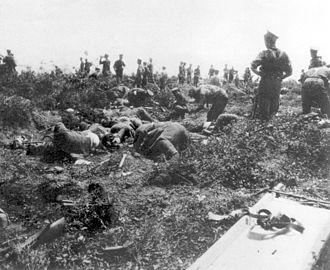
On 25 April 1915, the ANZAC forces landed on the Gallipoli peninsula, quickly incurring about 5,000 casualties against a Turkish counterattack before bogging down into trench warfare.[130] ANZAC troops struggled against Turkish machine guns, as well as high cliffs, steep ridges, deep gullies, and thick scrub.[131]
In command of the Turkish defenders was Mustafa Kemal, who was the right man at the right time to marshal the defenses. Despite having been caught largely by surprise and given no instructions from his command for hours, Kemal was able to swiftly organize and execute a strategy to halt the Entente invasion.[132] This bought time for the Ottomans to bring in more troops while the Entente forces were stuck on the coastline. Kemal became a national hero for his victory during the campaign.
Despite barely having a beachhead in Gallipoli, the ANZAC troops attempted to launch a breakout several times, which all resulted in costly failures.[133] For eight months, the trench lines in Gallipoli barely moved as soldiers suffered from heat and disease. In October, a surprisingly well-organized withdrawal brought the campaign to an end, but not before the Entente had suffered 250,000 casualties, including 58,000 deaths.[134] The Ottomans fared even worse, with 300,000 casualties, of which 87,000 died.[134]
Winston Churchill lost his job in the wake of the military disaster, and resigned political office to serve in the British military.[135]
Misery and slaughter[edit]
.jpg)
Deadlock in the west[edit]
While the Germans had overrun Belgium and much of northern France, a tiny sliver of Belgian soil around the city of Ypres still remained free. This created great interest in the region for both parties, as the Germans wanted to finish their conquest of Belgium and press on to the French ports beyond, and the Entente couldn't stomach surrendering the sliver of Belgium they still held.[136] This set the stage for the blood-soaked year of 1915 on the Western Front.
The First Battle of Ypres began in late 1914 before being interrupted by the onset of winter. While the weather was too harsh for fighting, both sides set about constructing elaborate trench networks to stave off attack.[137] The sickening horror of warfare in this new era became apparent when the fighting resumed in 1915. Offensives were bitter and confused, with early trenches unable to protect soldiers against artillery fire, which proved constant as a result.[136] Rifles and machine guns cut down soldiers as well. The First Battle of Ypres ended inconclusively, Germany having lost 130,000 men compared to Entente losses of around 100,000.[136] But the pointless killing was far from over.
While trenches were a valuable defense against infantry assaults, a hit from an artillery shell could still shred a man with shrapnel or bury him alive under the trench's collapsing walls.[138] Snipers also posed a threat, and fighting alternated between long periods of boredom and then sudden chaos and death. Even without enemy action, trenches were miserable places to live. Rats and lice tormented soldiers and helped spread disease, and trenches were thoroughly unsanitary due to human waste and persistent dampness.[139] The constant cold and damp also inflicted trench foot on many soldiers, complications of which included blisters, nerve damage, gangrene, and potentially amputation.[140]
Calamity in the east[edit]

With the Western Front settling into stagnant trench warfare, the German Empire's command fell into rancor over whether to turn their attention eastwards. Paul von Hindenburg, the architect of the great victories over Russia, favored turning east, while Chief of Staff Erich von Falkenhayn clung to his faith in the original plan to knock out France first.[141] In the end, the General Staff agreed to commit more resources against the flagging Russian Empire, beginning one of the darkest chapters of the war.
German forces crashed into Russian lines throughout 1915, a situation the Russian Empire was entirely incapable of handling. With inadequate railroads, a backwards industrial scene, and a hopelessly corrupt military administration, Russia quickly ran out of ammunition and began falling back against the German onslaught.[142] As the Germans advanced into Poland and then Ukraine, tsarist officials abandoned their posts and fled, along with waves of civilians fearing brutal treatment at the hands of the victorious enemy.[143]
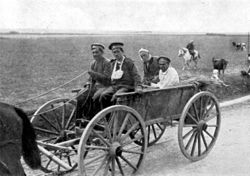
In response, Tsar Nicholas II placed most of the empire's territory west of Petrograd and the Dnepr River under absolute military rule. Military officials persecuted minorities including Jews, Roma, and Ukrainians due to suspicion of disloyalty, forcibly deporting them away from combat zones.[143] They also enacted classic Russian scorched-earth tactics by razing villages and forcing even more people out of their homes.[143] Many refugees ended up fleeing from their own side. Official numbers claim that there were 4.9 million refugees in the Russian empire by January 1917; however, more recent historiography has demonstrated that the Russians greatly underestimated the scale of the problem.[143] These people, forced out of their homes on hours' notice, endured hunger, disease, and overcrowded conditions.
If that wasn't horrendous enough, food in general became a severe problem for Russia and its subject peoples. The consequences of total mobilization were a disaster for the empire, as it drafted a total of around 15.5 million by the end of 1917, almost all of whom had been peasant farmers prior.[144] As a result, Russia deeply cut into its ability to produce food while also massively expanding its demand to feed soldiers. This problem was compounded by the loss of huge swathes of arable land to German occupation.
On the subject of occupation, neither Germany nor Austria-Hungary had made any plans whatsoever prior to the war as to how to manage such a widespread and prolonged occupation regime.[145] While the Habsburg forces focused on exploiting their occupied territory for resources, the Germans made rudimentary attempts at repairing damaged infrastructure and appeasing the Polish population.[145] Nonetheless, Germany had its share of shittiness, too, recruiting Poles to work in the Fatherland and then refusing to let them return home again. It was even worse in the Baltic region and Belarus, which were under the direct control of Erich von Ludendorff, a particularly vile German general who wanted to revive the old tradition of German colonization of the east under a modern military regime, leading to a dysfunctional regime characterized by widespread brutality towards civilians.[145] German policies of using civilians for labor further cut into food production, a problem compounded when the German occupiers began seizing food for their own military.[145] This, of course, led to widespread famine throughout the occupied territories.
Intensifying horror in the trenches[edit]

The Germans introduced the modern flamethrower to the battlefield in February 1915. A few months later, the Germans, French and British began the Second Battle of Ypres in April 1915 (because the first one was so much fun). It was a relatively small operation that ended inconclusively, but it was intended as a testing ground for Germany's newest weapon: poison gas. Having sought a way to break the stalemate of trench warfare, German chemist Fritz Haber (previously known for inventing mass-producible nitrogen-based fertilizers) had developed chlorine gas.[146] German soldiers popped the gas canisters by hand and relied on the wind to carry it over to the French; this was obviously very stupid, and caused horrific casualties among their own men.[147] While the gas attack came as a great surprise to the allies, the Germans failed to take advantage of it, and the Second Battle of Ypres ended inconclusively.
The British debuted their own chlorine gas at the Battle of Loos later in the year, but they also inflicted casualties on their own men for little advantage. They also discovered that not being able to communicate effectively with the forward elements of their attacking force after they've captured their objectives is not conducive to operational goals, other than ending up right back where the attack started, with nothing to show for it but casualties.[148]
Gas ultimately proved a pointless cruelty added onto the already shitty situation on the Western Front. This was because it didn't create any genuine strategic advantage, due to the quick adoption of countermeasures such as gas masks, and gas attacks often caused more casualties on one's own side than against the enemy.[149] Even so, gas warfare only escalated throughout the war. With chlorine gas having proven ineffective since it had a distinctive and easy-to-spot color, the Germans moved on to phosgene gas (carbonyl dichloride) later in the year. Phosgene was colorless and was only detectable by a faint "musty hay" odor.[150] It reacted with proteins in the alveoli of the lungs, leading to suffocation. An estimated 85% of the 91,000 gas deaths in WWI were caused by phosgene.[150] Mostly commonly used, however, was mustard gas (dichlorodiethyl sulfide), which caused horrendous chemical blisters on contact with skin.[150]
The war reaches new heights...[edit]
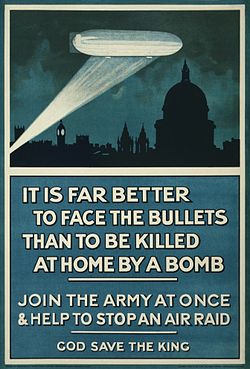
“”Now a dogfight is rather an exciting game actually. You’d dive onto the first Hun you come across, you open out your guns – although you may not have had time to get your guns sighted – and no sooner you’ve got your guns on him, someone else has got their guns on you.
|
| —Thomas Isbell, British pilot of the 41 Squadron[151] |
As soldiers suffered through hell on earth, the fighting reached the skies for the first time. While balloons had been used for reconnaissance since the Napoleonic Wars,[152] World War I marked the first time that fixed-wing aircraft were used extensively for both intelligence and combat operations. At first, airplanes were used mostly for taking aerial photographs of trench systems in order to better plan attacks; by the end of 1914, however, airplanes were the principal means of gathering intelligence on enemy positions.[153] This proved so effective that historians now argue that aerial reconnaissance played a role in the war's stalemate, since commanders could react to counter enemy movements within hours.[153] The Germans notably used airplane intel to achieve their great victory at Tannenberg over the Russians.
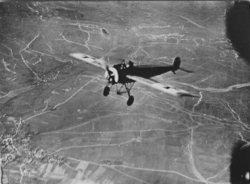
In 1915, aerial warfare (unfortunately) took another step forwards when the Germans introduced the modern concept of strategic bombing. Formerly used for luxury travel, airships such as the German Zeppelins became weapons of mass destruction, carrying large bomb payloads and flying over British cities. While their attacks killed relatively few people, they were distressingly difficult to counter.[154] The British public were demoralized by the possibility of being bombed in their own homes far from the front lines. They were only successfully countered in 1917 with the advent of incendiary bullets, which could ignite the hydrogen in their envelopes.[155] Unfortunately, by that point, the Zeppelins could be replaced by airplane bombers, which killed more civilians until the war's end.
Meanwhile, the flimsy little scout planes from the early war were replaced by heavier, armed variants, which could now shoot at each other. Pilots and aircrew were no longer safe, and dogfights started to become common after 1916. Planes also had early roles in tactical bombing by striking railway stations in enemy-held territory with bombs.[156] On the Entente side, the air war was deadly. The Germans generally had better aircraft for much of the war (notably the "Fokker Scourge" of Eindecker monoplanes, with their ability to fire forwards through the propeller), and the prevailing winds across the Western Front generally favored aircraft attacking from Germany.[157]
...and new lows[edit]
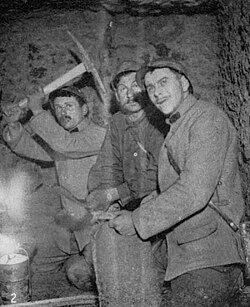
As terrifying as fighting in the skies could be, an even more wretched form of war emerged underground. During the struggle to break the stalemate on the Western Front, military commanders on both sides decided to try tunneling beneath enemy trenches to plant explosives. While this is an ancient idea in truth, the advent of modern high explosives meant that it could be more effective than ever. At the Battle of Messines in 1917, for instance, 455 tons of explosive placed in 21 tunnels over the course of a year created a single massive explosion that killed an estimated 10,000 Germans.[158] One witness said that some of the debris raining down were the size of houses.[159] Holy shit.
While the payoff could be huge, the job of placing those explosives was one of the least desirable in the entire war. Tunnelers, usually miners or sewage workers in peacetime, faced long hours underground engaging in grueling work. There was also the ever-present threat of being buried alive if their tunnel collapsed upon them. In 2011, British military historians discovered 28 men who had been buried in a collapse in 1916.[158] In another location, German historians are trying to find the bodies of an estimated 100-250 men who were either buried in an explosion from accidentally detonated ammunition or otherwise suffocated when toxic gases from the blast seeped into the newly-formed tomb after them.[160] Some of the shittiest possible ways to go out.
Cave-ins weren't the only threat, either. Enemy forces would dig counter-tunnels to attempt to find and destroy the sappers targeting them. Both sides would use stethoscopes to hear each other working and talking, and if an enemy tunnel was found, it could be destroyed with a carefully planted mine to trap the men in their own tomb.[161] Or worse, a tunnel could be breached and then flooded with poison gas. An agonizing death in near-total darkness. Failing that, desperate hand-to-hand combat in the claustrophobic tunnels could ensue if the tunnelers accidentally broke into each other's tunnels or collapsed into each other.[162]
Trying to tip the scales[edit]

Strategic situation in Europe after Italy and Bulgaria joined the bloodbath
Italy joins the war[edit]

“”Do you want to be spectators in this great drama? Or do you want to be its fighters?
|
| —Benito Mussolini, October 1914[163] |
Long hostile to Austria despite being a member of the Triple Alliance, Italy initially stayed neutral and refused to join the war on behalf of its two alleged allies, citing the terms of the alliance that only committed them to join Germany and Austria in case of a defensive war. They also believed they were a third wheel in the alliance, having been left out of any decision-making during the crisis over Serbia.[164]
With Italy having rejected its former allies, the Entente were all too happy to woo the strategically important nation to their side. In the 1915 Treaty of London, the Entente powers promised them annexation of the so-called "Italia Irredenta," lands that Italy claimed against Austria-Hungary for historical and cultural reasons.[164] These lands included the Dalmatian coast (now part of Croatia), the Italian-speaking areas of South Tyrol, and the city of Trieste.[165] This territory was held by the Habsburg empire, the major contributing factor to Italy's sour feelings towards them.

In May 1915, Italy declared war on Austria, hoping it would be a quick war since they weren't terribly strong or war-ready at this point.[166] The only truly good outcome for Italy would come by quickly overrunning the Austrians before the Germans could come to save them. With the benefit of hindsight (and basic maps), we can see that this wasn't about to happen, as Italy's route of attack would take it either into the Alpine mountains, or into the Isonzo River, or perhaps both simultaneously.[166] This was very bad terrain for any belligerent, especially one hoping to launch a quick invasion.
Italian Chief of Staff Luigi Cadorna![]() , a strong contender for the worst commanding general of the war, decided to hold the Alps and focus on the river. However, he completely failed to notice the importance of artillery in other fronts of the war while planning his attack.[167] He also shared his contemporaries' cultish obsession with constantly being on the offensive, which is even more unforgivable in his case, since the world was already almost a year into watching failed attacks on the fucking Western Front at this point.[166]
, a strong contender for the worst commanding general of the war, decided to hold the Alps and focus on the river. However, he completely failed to notice the importance of artillery in other fronts of the war while planning his attack.[167] He also shared his contemporaries' cultish obsession with constantly being on the offensive, which is even more unforgivable in his case, since the world was already almost a year into watching failed attacks on the fucking Western Front at this point.[166]
Unsurprisingly, the Austro-Hungarians easily guessed that Cadorna would attack across the Isonzo River. While they had few troops to spare for this new front, they easily used the mountainous terrain and the river itself to maintain a strong defense against the Italians.[166] For his part, Cadorna firmly held the conviction that the only reason human wave attacks failed against strong defensive positions thoroughly sprinkled with heavy machine guns was that his men didn't have enough fighting spirit. He tried to address this problem by continuously firing subordinate officers who disagreed with him (217 to be exact).[168] He was also infamously brutal in using the death penalty against his own soldiers, authorizing the execution of over 750 men.[167] The Italian Front settled into a stalemate that cost the Italians upwards of 300,000 men; over the course of 1916, the Italians would lose another half-million.[169] Cadorna, meanwhile, demonstrated his military genius by fighting no less than twelve fucking battles over the Isonzo river.[170]
As horrible as the Isonzo proved to be, the Alpine Front was on a whole different level. Uniquely in the history of warfare, the Italians and Austrians fought across the peaks and valleys of the perilous Dolomite Alps. In subzero temperatures, men had to dig tunnels through glacial ice, string cables across mountains, and haul their cannons and machine guns up rope ladders to fight.[171] Alongside their modern weapons, the soldiers used the very terrain they fought in to kill their enemies. They would roll boulders onto enemy positions and deliberately trigger avalanches to bury men alive.[171]
Bulgaria joins the war[edit]
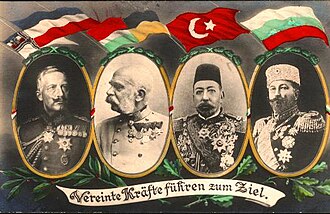
“”Bulgaria cannot be denied its historical and ethnographic rights. It cannot exist without Macedonia, for which it has shed so much blood.
|
| —Vasil Radoslavov, Bulgarian prime minister, just before Bulgarian entry into the war[172] |
After the two devastating Balkan Wars in 1912 and 1913, Bulgaria initially had no interest at all in getting involved in yet another fight.[173] As war raged on, however, the two belligerent factions began putting heavier pressure on Bulgaria to pick a side. With stalemate on almost all fronts, Bulgarian entry could tip the scales.
Meanwhile, Bulgaria had become estranged from its former Russian friend as a result of the Balkan Wars, in which Russia refused to support them against Serbia or Greece.[173] Given the two nations' shared culture, religion and historical alignment, this felt like a great betrayal for the Bulgarians. Bulgaria also still wanted to annex the Macedonia region from Serbia and potentially take Greece's coastline on the Aegean, proposals that the Central Powers were all too happy to make.[172] With the Entente getting kicked out of Gallipoli and Russia eating rocks on the Eastern Front, Bulgaria's options seemed pretty clear.
Bulgaria entered the war in late summer of 1915, once again preparing to sacrifice a wave of its young men for the sake of making its borders look bigger on a map. This proved to be a terrible idea, as the resumption of war so soon after the Balkan conflicts was extremely unpopular, both politically and popularly. All opposition parties were against the move, and Agrarian Union leader Aleksandŭr Stamboliyski met directly with the Tsar to warn him that war would be a disaster. The Tsar responded flippantly and then informed Prime Minister Radoslavov of the meeting; the PM promptly had Stamboliyski arrested and sent before a military tribunal to be sentenced to life in prison.[172] The warnings proved true; Bulgaria's fragile, already war-torn economy could not support the demands of a modern war. Its population of 4.8 million were largely agrarian peasants, and the nation had little industry.[173] The war immediately caused hardship for the people, but its surprise entry allowed it to win a major victory against its primary enemy: Serbia.
Serbia falls[edit]
.jpg)
“”The bombardment of Belgrade was one of the fiercest in the history of the present war. Over 50,000 projectiles fell in the town in the first forty-eight hours. Nothing was spared. Over eighty shells struck or fell around the American Hospital… in spite of the fact that a Red Cross flag, visible for miles, was flying from the roof.
|
| —Gordon Gordon-Smith, British reporter in Belgrade[174] |
With Bulgaria entering the war, the Central Powers could now invade Serbia from two sides starting in October 1915. Serbia's reckoning had finally come. Whereas before the Serbians could stand up to Austria (distracted as it was by Russia) against all expectations, its forces could not stretch far enough to defend its broad border with Bulgaria.[175] Serbia's industrial shortcomings had also caught up to it by this time, with many of its soldiers so short of equipment that they couldn't even find boots to wear during winter.[176]
In this renewed attack starting on 6 October, the Central Powers mustered a combined force of about 600,000 soldiers, while poor Serbia could only manage 250,000 men spread across ten under-strength divisions.[174] The Central Powers also had a vast supply of heavy artillery pieces, which they used to open the offensive by launching a massive bombardment against Belgrade. By 9 October, they had taken Serbia's capital, forcing thousands of refugees to flee along with the army.[174] Retreat became a total collapse as German heavy artillery blasted hastily-dug Serbian trenches out of existence.

Rather than surrender, the Serbian government, led by Prime Minister Nikola Pasic, decided to evacuate Serbia and fight on from exile. Their plan was to retreat into neutral Albania, which would require moving the remnants of the Serbian army, as well as hundreds of thousands of civilians, across the Prokletije ("Accursed") Mountains in the dead of winter with little supply.[177] This was gonna suck. The retreat became one of the war's worst humanitarian catastrophes, as an estimated 70,000 soldiers and 140,000 civilians froze, starved to death, died of disease, or were killed by bandits during the agonizing journey.[177]
Occupation by the Central Powers was especially horrible for those parts of Serbia handed to Bulgaria. Authorities banned the Serbian language and burned books, publicly executing anyone who resisted them.[178] In the Surdulica massacre, Bulgarian forces murdered some 3,000 Serbian civilians they alleged to be a political threat.[179] Bulgarian occupation was so oppressive that mass uprising occurred in 1917, which they suppressed by killing around 25,000 people.[178]
It wasn't much better for the parts of the country occupied by Austria-Hungary. The military administration kept the Serbian population in line through a draconian system of punishments that included corporal punishments, hard labor, and public hanging.[178] Economic exploitation by the Austrians also entailed mass deforestation, seizure of industrial assets, and confiscation of housing and food.[178] This naturally caused famine and misery, which also allowed epidemics to sweep across the weakened population to kill the young and elderly. A quarter of Serbia's 4.5 million people died in World War I, with some 60,000 having been directly executed by occupying authorities.[180]
The undersea menace[edit]

“”The suction of the liner was pulling us back. Every time the oars went forward, we were going as if we were going to be drawn under. Eventually, we got away and I saw the funnels one by one disappearing. I saw all those lifeboats – the lifeboat I was in was the only one saved on that side. There was a submarine on the surface watching us. I saw those sailors watching all those bodies of people and wreckage.
|
| —Lusitania survivor Alice Drury describing what it's like to escape a U-boat attack[181] |
Blockaded by Britain's navy, the Germans desperately searched for a naval strategy. The sinking of the Lusitania had forced the German submarine fleet to adopt regulations in line with international law, warning merchant ships before sinking them and making efforts to save their crews. But these limitations prevented submarines from sinking enough cargo to be worth it, and they also exposed the submarines to retaliatory attacks. By the end of 1915, the German government once again saw U-boats as the answer.
First they tried using U-boats against British capital ships by using their surface fleet to lure them into underwater torpedoes.[182] This was largely unsuccessful, and the major naval battle of 1916, the famous Battle of Jutland, saw no U-boat involvement at all. Jutland, the largest naval engagement of the war, proved Britain's supremacy when the German High Seas Fleet had to be confined to port afterwards, despite sinking more British ships than they had lost.[183]
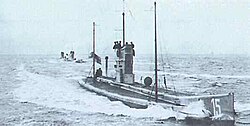
Eventually, the Entente started rolling out countermeasures to the submarines. Merchant ships were armed with artillery and advised to try and ram the submarines if all else failed.[184] This made submarine missions even more dangerous and miserable for the crews. U-boats were already hard enough, being little metal cans with 20-50 men crammed inside. U-boats only had one (crank-operated) toilet with no showers, and were usually at sea for months at a time, while the poor men had to share hammocks to sleep.[185]
The widespread arming of merchant ships, coupled with the losses their submarines were taking due to playing by the rules, convinced the Germans to go back to unrestricted submarine warfare in March 1916.[186] The U.S. and Dutch governments were enraged by this. The Americans were especially pissed off when long-distance raiders like the U-53 began sinking Entente merchant ships right off the American coast as the US Navy was forced to stand by.[187] This period proved extremely stressful to the British war effort, with U-boats sinking 143 ships in exchange for just four losses over just a few months.[186] It only ended when the UB-29 sank the passenger liner SS Sussex without warning, despite German pledges that it would not sink passenger ships.[188] No Americans were killed, but the U.S. government still threatened Germany into backing down. But German desperation was growing, and the threat of American intervention wasn't going to be an adequate deterrence for too much longer.
The Arabian Revolt[edit]
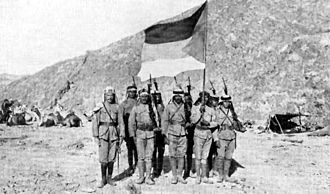
Back in the Middle East, the beleaguered Ottoman Empire was about to run into yet another headache. In 1908, the Ottoman Empire had sparked huge unrest among its Arab subjects by building a railway through the Hejaz region, which allowed for the placement of imperial tax collectors and soldiers.[189] The Hashemite clan, rulers of the holy cities of Mecca and Medina and allegedly descended from Muhammad himself, began positioning themselves at the forefront of a potential Arab uprising.[189] They had to jockey for this position against the Saudi clan, adherents of Wahhabism who had repeatedly caused trouble for the Ottomans over the last couple of centuries.
The Arabs got their chance upon the outbreak of war. Largely ignoring the Ottoman declaration of holy war, Sharif Hussein ibn Ali of the Hashemites contacted the British to inquire about potential aid. The British responded with covert shipments of cash and weapons, allowing Hussein to build his cause throughout 1915.[189] He lit the flames in 1916 by ousting Ottoman garrisons from the holy cities. Hussein declared that the Ottomans had violated the sacred tenets of Islam by discriminating against Arabs, their fellow Muslims.[190]:288:297
British military liaison T.E. Lawrence, better known as Lawrence of Arabia, arrived in October to better coordinate British aid for the revolt.[191] By attacking infrastructure and capturing ports, the Arabs and their British helpers hoped to tie down the 12,000 Ottoman troops in the region and prevent them from interfering in the British invasion of Palestine;[191] they would prove to be largely successful.
However, in order to keep the Arabs on their side, the British promised to support the creation of an independent Arab kingdom led by Sharif Hussein.[192] The future borders of this kingdom were deliberately left vague to the Arabs. Between themselves, the British and French concluded the Sykes-Picot Agreement, which divided the Middle East into regions of colonial domination.[192] Included in these spheres of influence would be Iraq and Syria, lands that Hussein demanded for his Arab state and which the British had avoided talking about to them. There would be trouble ahead.
This still isn't working[edit]

Strategic situation in Europe at the height of Verdun and the Brusilov Offensive
Strategy of massive casualties[edit]

“”At the start of the battle, there were trenches, but as the months went by with shells falling all the time in many places, there weren’t any trenches at all. The ground was just completely churned up. Any trees were smashed, and men took shelter where they could, in shell craters and in holes in the ground.
|
| —Christina Holstein, British historian, on the conditions soldiers faced at Verdun[193] |
The year 1916 opened with the Western Front in deadlock. There was no realistic hope to break this, either, meaning that the war could not end unless people who weren't willing to negotiate suddenly decided to negotiate. Erich von Falkenhayn, Chief of the German General Staff, decided to shift his focus towards inflicting as many casualties as possible in order to "bleed France white".[194] Germany had a significantly larger population than France did,[195] meaning it could theoretically afford to lose more people and outlast France in a war of attrition. In other words, this was a ruthless and cold-blooded strategy.
The first step in killing France would entail Germany's first major attack on the Western Front since the onset of trench warfare. Falkenhayn chose the fortress-city of Verdun for his offensive, a region whose ancient history and strategic logistical importance ensured that the French could never retreat from it.[196] The more the French stubbornly held on to Verdun against his massive attack, Falkenhayn reasoned, the more of their soldiers his men could kill. The Germans sent about 100,000 men to augment their forces in the region, and shipped in heavy siege artillery from Serbia and Russia.[197] French reconnaissance aircraft spotted too many artillery batteries to mark on their maps.[197] With these heavy cannons, the Germans planned to pound every bit of ground they could with explosive shells and then send their infantry to mop up whoever survived.

It wasn't to be so simple. The Battle of Verdun opened in February 1916, and became the longest battle of the war (and of modern history). The first five days of the attack went as planned, but German commanders became increasingly reckless as their objective seemed in reach. They committed more infantry into attacks and began losing men at a similarly brutal rate as were the French.[196] French General Philippe Pétain took command of the defenders, and used a tactic of rotating troops to keep them fresh, which proved to be an effective policy.[196] The French also brought more artillery to Verdun, meaning they could hit back against the German cannonry.

While Falkenhayn's plan had failed, the Germans couldn't stomach abandoning an objective they had come so close to achieving. Instead, they grimly fought on for Verdun, turning the battle into a blood-soaked contest of attrition. They brought new weapons to bear at Verdun, including the first mass usage of flamethrowers, to give cover to advancing infantry.[198] The Germans also extensively used phosgene gas, firing 110,000 gas shells in the month of June, such a high concentration that French gas masks were rendered ineffective.[199] While these weapons didn't alter the outcome of the battle, the flamethrower still terrorized soldiers confronted with it, and the gas added to France's hideous death toll at Verdun and further overburdened its hospitals with the sick.

To relieve the French fighting at Verdun, the British launched an offensive on 1 July that became the Battle of the Somme. The British bombarded German trenches with artillery, also believing that a massive shelling would make the defenders in the trenches unable to fight back;[200] Unfortunately, like Falkenhayn, they were wrong. British and Commonwealth troops were mowed down by German machine guns on the first day of their attack, losing 19,240 British soldiers in the bloodiest day in the nation's history.[201] While these losses were hideous, the British leadership refused to halt the battle while the French were still fighting for their lives in Verdun. Thus, the Somme became yet another war of attrition featuring relentless attacks by the British and stubborn German counterattacks. Significantly, the British introduced tanks at the Somme during September,[202] which were crude and ineffective but scared the hell out of the German defenders.
While the Somme largely failed as an offensive, it did force the Germans to draw forces away from Verdun. By winter, both campaigns were forced to come to an end due to exhaustion and poor weather. In the end, the German plans had backfired. German commanders had senselessly ordered attacks regardless of expected casualties, meaning that Falkenhayn's plan to bleed France white proved just as bad for Germany.[203] Falkenhayn got the sack for this, and Hindenburg replaced him. In the end, Verdun resulted in about 700,000 casualties, split roughly evenly between the Germans and the French.[204] At the Somme, Britain suffered 420,000 casualties and the French suffered 200,000 in supporting them, while the Germans lost at least 450,000 killed and wounded.[205] Holy fuck.
Russia's last gasps[edit]
.jpg)
While Britain and France suffered on the Western Front, Russia had slowly recovered from the devastating losses of 1915. By the outset of the Battle of Verdun, the Russians were ready to launch another offensive in the hopes of retaking some of their land and taking pressure off the French.[206] This led to a hastily-planned attack near what is now Vilnius, Lithuania, which resulted in disaster. The Russians held a huge numerical advantage: 350,000 men to the Germans' 75,000.[207] But bad tactical decisions resulted in waves of Russian men being cut down by German machine gun fire, resulting in Russian fatalities being about five times worse than that of the Germans.[207]
This costly failure finally beat it into some Russian commanders' heads that their tactics needed to change. Enter forward-thinking general Aleksei Brusilov, who noticed that up to this point, the belligerents of the war generally launched offensives in a single sector, allowing the enemy to redeploy forces to meet the new threat.[208] Rather than keep repeating this failed pattern, Brusilov decided that Russia should attack in many places at once across the entire front. After receiving the go-ahead to test his theories against the Austro-Hungarian lines to the south, Brusilov began extensive preparations there. His men moved their positions forward as far as they could under the cover of night, and Russian spies sent falsified radio and courier messages to confuse German intelligence.[209]
Brusilov attacked on 4 June with a brief but intense artillery bombardment, catching the Central Powers by complete surprise and thus being able to make significant breakthroughs against the Austro-Hungarian lines. On the other hand, other Russian commanders on the front failed to capitalize on the offensive by launching their own attacks, spoiling Brusilov's plan and allowing the Germans to redeploy divisions to bolster their failing Austrian allies.[208] Russia's lack of infrastructure and reliance on horse-drawn wagons for transport also meant that Brusilov couldn't get enough supplies to his troops to keep up a steady advance.[210] The Brusilov Offensive thus failed to gain a decisive victory, exhausting Russia for no real strategic benefit.
On the other hand, the initial successes were huge, and demonstrated what Russian forces could do if competently led (this, along with logistics, would consistently prove Russia's undoing in the future). Brusilov's armies captured some 200,000 enemy soldiers and killed many others, and he had dealt a crippling blow to Austria-Hungary's ability to fight independently of its ally.[210] For the rest of the war, the Austrians would find themselves more and more dependent on Germany.
For Russia, the offensive was its last great chance to accomplish any great victories against the Central Powers. The failure of the offensive and the casualties Russian forces endured (1.4 million!)[211] further soured the opinions of both the populace and the military towards the war and their own incompetent government. General Brusilov himself blamed the incompetence of the Tsarist regime for his failure, and Russia's only great general became a supporter of the revolutions to come.[212]
Romania joins (and leaves) the war[edit]
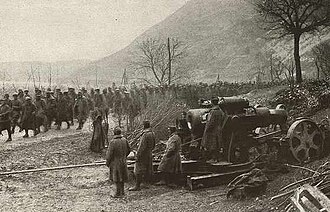
As the Russians kicked the Austrians' ass in the Brusilov Offensive, Romania began to consider its options for entering the war. Due to having a king belonging to the House of Hohenzollern (the same royal dynasty that had united the German Empire), Romania had previously been on friendly terms with the Central Powers.[213] The country had even signed a pact obliging it to defend Austria-Hungary should it be attacked, but it truthfully argued that it didn't need to join the war at first since Austria had started it. What complicated this was the Kingdom of Hungary's control of Transylvania, a Romanian-speaking region which many Romanian nationalists would have quite liked to see join them.[214] Yes, we're looking at a situation very similar to that which faced Italy a year before.
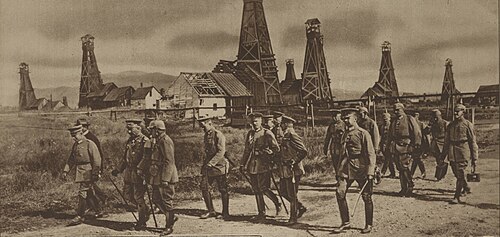
Since Austria was eating shit on the Eastern Front, the Romanian government and its new pro-French king felt quite confident in being able to quickly take Transylvania and realize their dream of a united Romania. After they declared war in August 1916, however, they promptly ran into some major fucking problems. First, the aforementioned Brusilov Offensive had run out of steam very quickly, and Germany was able to regain initiative against the Russians. This had already happened by the time Romania jumped into the fray. Even worse, the Romanian army suffered from a serious shortage of equipment, while the nation as a whole had an underdeveloped railway network.[215]
Romania delivered Austria-Hungary a sucker punch to the balls by overrunning big chunks of Transylvania. After that, shit went bad for them. By October, the Central Powers had rallied and launched a counter-invasion against Romania. Facing Austrian and German troops to the north and west, and Bulgarian troops to the south, Romania fell within two months.[216]
And now we come to the part of the story which shows the real reason why Romania was so important in modern European history. In 1857, the Romanian city of Ploiești had opened the world's first systematic oil refinery, soon allowing Romania to become Europe's other major oil exporter besides the Russian Empire.[217] By the time of the Great War, motor vehicles and airplanes were in use, while railroads and industrial machines needed petroleum products as lubricants.[218] In a last desperate gambit to fuck over their German conquerors, the Romanian leadership called British engineer Colonel Griffiths and asked him to help destroy the nation's petroleum industry during their retreat. By pouring cement into wells, breaking pipes, and finally dumping oil and burning it, Griffiths and the Romanians were able to destroy hundreds of millions of tons of crude oil and the machinery to extract and process any more over the course of about a week.[219] The Germans didn't resume production until spring of 1917; however, what oil they could extract combined with the grain they could requisition were vital to keeping Germany in the fight.
Desperation on the Western Front[edit]
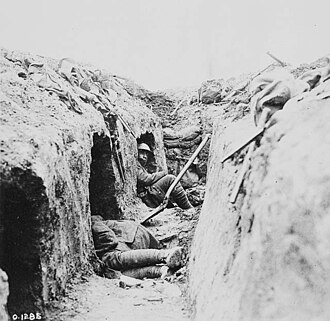
While Germany benefited greatly from the growing dissent in Russia and the conquest of Romania, it still desperately needed to have a much better year in 1917 than it had in 1916 if it was to pull some kind of meaningful victory out of this endless war. As Chief of the General Staff, Falkenhayn had been tossed out on his ass in favor of Hindenburg and his lackey Ludendorff, who both favored pushing on Russia until it fell. If Russia went down, millions of German soldiers stuck in the East could be redeployed against the French and British. This was it, the nation's desperate leadership thought. This was how Germany could win.
Until then, they needed to hold the Western Front. And to this end, the Germans spent the winter lull between 1916 and 1917 building a massive system of fortifications and reserve positions behind their lines.[220] Then they pulled back to the fortification, destroying every bit of occupied France they could in order to impede the Entente from following them and as just one more middle finger to the French.[221] They destroyed infrastructure and buildings, sabotaged wells, and planted booby-traps all over the place. Nice one, Germans.
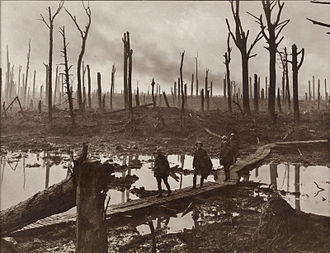
The fortification system that they retreated to became known as the Hindenburg Line, Germany's last stand in the West during its reckoning with Russia. The Entente, exhausted as they were, were going to cross the French wasteland and try to attack it. Here we fucking go again.
While the Entente had learned some tough lessons during Verdun and the Somme, logistics problems and the German fortifications once again caused them to bog down into stalemate. The first great attempt on the Line, the Battle of Arras, saw casualties surpass 150,000 for the British and the Canadians, and 100,000 for the Germans.[222] In April, French Commander-in-Chief Robert Nivelle decided to try again, fully believing against all evidence that an overwhelming attack could knock a hole in the Hindenburg Line. While the French were able to pull off some advances, this came at the brutal cost of 118,000 casualties and 28,000 deaths.[223]
Nivelle's failure, perhaps more than any other factor up to this point, demonstrated that the Entente needed 1917 to go their way just as much as the Germans did. French morale collapsed after his offensive fell apart, as French soldiers and civilians really had believed Nivelle's claims that a breakthrough was coming. Bitterly disappointed factory workers, many of whom were women, went on strike.[224] News of this inspired similar actions among French soldiers throughout May and June, reaching a point where 68 of the army's 112 divisions were considered unable to fight. This wasn't quite a mutiny, as French soldiers were still happy to man their posts and defend their homeland.[224] They just weren't going to allow themselves to be sacrificed pointlessly in "over the top" offensives against German fortifications. Luckily, Nivelle got the sack, and the ol' reliable Philippe Petain decided against harshly punishing most of the quasi-mutineers.
Meanwhile, British and Commonwealth forces launched the Third Battle of Ypres (also known as Passchendale) in July, promptly running into complications brought about by foul weather and stubborn German resistance, including lots of mustard gas shells. Commonwealth and French losses approached 300,000, while German casualties were about 260,000.[222] Hardly a great victory. The Battle of Cambrai went better some months later, as the British were able to muster several hundred tanks to assist. There would be no breakthrough, however, as these tanks broke down quickly or were otherwise taken out by German artillery.[222]
In short, more stalemate, more death, and no real indication that any of it was going to change.
Beginning of the end[edit]

Strategic situation in Europe after the October Revolution
The Russian Revolution[edit]
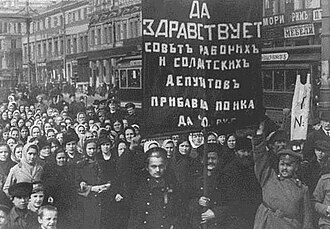
Facing high casualties combined with shortages of food and basic supplies, the Russian people were just about fed up with the war - not only that, they were fed up with their whole damn government. For decades, the Russian Empire had been among the most backwards states in Europe. The Industrial Revolution had done little for them, and the empire still had a near-Medieval social structure where almost the entire population were agrarian peasants who labored under an autocratic absolute monarchy.[225] Tsar Nicholas II was widely known to be lazy, weak-willed and constantly distracted by the illness of his heir. He clung to power in part through a secret police force called the Okhrana, which was formed in 1881 to combat socialism and other oppositional ideologies through the heavy-handed use of mass surveillance, torture and extralegal killings.[226]
In short, life sucked, and the pointless, brutal war was the last straw for the Russian people. On 22 February 1917, metal workers in Petrograd went on strike, starting a mass movement that brought an estimated 200,000 protesters into the streets to demand an end to the war and a solution to the ongoing food crisis.[227] Even with the city's industry ground to a halt, soldiers refused to crush the protesters, and in fact started joining the movement against the Tsar. They were followed by demonstrators honoring International Women's Day, a celebration that quickly turned into an antigovernmental rage-fest.

Meanwhile, Tsar Nicky was on the front lines trying to hold his failing military together, leaving his disinterested wife to manage affairs in the capital. Tsarina Alexandra repeatedly downplayed the risk of public discontent, believing that protests were simply the work of "hooligans" and insisting that protesters would stay home because it was cold outside.[228] The State Duma, a collection of nobles and rich landowners who were the closest thing Russia had to a democratic body, started begging Tsar Nicholas to come back to Petrograd and sort things out. When he ignored their warnings, the Duma went its own way and began to explore the possibility of forming its own government.[228]
To make things even more chaotic, socialists in Petrograd organized themselves into the so-called "Petrograd Soviet", pledging to represent the workers, soldiers and sailors of the capital city. With two rival governments formed and his soldiers refusing to follow orders at home, the Tsar finally decided it might be a good idea to head home. However, he made this decision far, far too late. His train was halted in the city of Pskov by a delegation from the Duma, which more or less told him that his time as ruler was up. They showed him telegrams from his generals to prove it, all of which demonstrated that he had no support and was out of options.[228] The Tsar was naturally pissed, but it's not like being mad ever changed anything.
Nicholas finally relented and signed away his crown, ending three centuries of Russian tsarist rule and heading off into what amounted to house arrest. After this, Russia came under the control of a "Provisional Government" that had been hastily assembled by the State Duma. The Duma, however, had never been much less out-of-touch than the Tsar, having been composed of rich assholes and landed nobles.[229] They chose to continue the war, seeing it as a matter of preserving Russia's honor. Its unelected status and temporary nature meant that the Provisional Government was widely seen as illegitimate, and its decision to continue the war that had caused so much agony further enraged the Russian people.
Meanwhile, Kaiser Wilhelm saw an opportunity to further weaken the Russians. His government chartered a train that returned Vladimir Lenin to Russia.[230] The stage was set for yet more Russian misery. Yippee.
The United States joins the war[edit]

The United States' entry into the war happened gradually, as President Woodrow Wilson had previously promised to stay neutral. American businesses sold materiel to the Entente for much of the war, and the U.S. government handed out loans.[231] Additionally, the U.S. was already cheesed off at Germany for its previous misdeeds during the submarine war, such as sinking the Lusitania. The U.S. also had a large population of Germans, many of whom began supporting Germany once the Great War started (this all changed later in the war when anti-German propaganda began spreading). German-Americans were now less eager to stay neutral.
In 1917, with the domestic situation in Germany growing more desperate and the British blockade still unbreakable, its leaders resumed their policy of unrestricted submarine war for the third time, a policy under which U-boats would sink all shipping, neutral or otherwise, in a German-designated zone around the British Isles without warning. Naturally, American vessels trading with Britain and France were caught and sunk.[232] The German ambassador to the U.S. frantically tried to prevent the resumption of unlimited submarine warfare, saying in a telegram to Berlin:[233]
“”If the U-boat campaign is opened now with any further ado, the President will regard this as a smack in the face, and war with the United States will be inevitable. The war party here will gain the upper hand, and the end of the war will be quite out of sight, as, whatever people may say to the contrary, the resources of the United States are enormous… At present, therefore, it is only a matter of postponing the declaration for a little while so that we may improve our diplomatic position.
|
.jpg)
The U.S. government responded to the German war policy with expected fury. Secretary of State Robert Lansing wrote to Wilson that the U.S. had no real choice but to punish Germany, as the other option was to cave to Germany's demands by severing trade relations with the Entente.[233] In February 1917, Woodrow Wilson officially severed diplomatic relations between the United States and Germany.
The final straw was the Zimmermann Telegram, a coded communication sent by the German foreign minister to the German ambassador to Mexico which discussed Germany's plan to ally with Mexico against the United States.[234] In classic World War I style, the Germans tried to play to Mexico's irredentism and public anger over then-recent U.S. interventions there,[235] specifically promising to help them regain the territory they lost during the Mexican-American War. Britain intercepted the message and leaked it to the U.S., hoping that it would be the push they needed to declare war.[236] While Germany's submarine warfare brought the government behind the war, the Zimmermann Telegram helped create the public support. Ironically, Zimmermann's offer was declined, as Mexico already was fighting a civil war![]() since 1910, and Mexican officials were well aware that Germany couldn't actually deliver on its promises of financial and material support due to Britain's blockade. Mexican president Venustiano Carranza
since 1910, and Mexican officials were well aware that Germany couldn't actually deliver on its promises of financial and material support due to Britain's blockade. Mexican president Venustiano Carranza![]() was able to obtain diplomatic recognition from the U.S. government in August 1917 in exchange for Mexico's neutrality for the remainder of World War I.[237] The telegram also interestingly suggested that Mexico try to convince Japan to leave the Allied Powers and join the proposed anti-U.S. alliance,[238] but Japan also declined the offer.
was able to obtain diplomatic recognition from the U.S. government in August 1917 in exchange for Mexico's neutrality for the remainder of World War I.[237] The telegram also interestingly suggested that Mexico try to convince Japan to leave the Allied Powers and join the proposed anti-U.S. alliance,[238] but Japan also declined the offer.
Thus in April 1917, the United States finally declared war on Germany, providing a much-needed infusion of manpower for the Entente.
Britain's Last Crusade[edit]
_-_British_General_Edmund_Allenby.jpg)
“”Today, the Crusades have ended.
|
| —Gen. Edmund Allenby upon occupying Jerusalem[239] |
“”Awake, Saladin. We have returned! My presence here consecrates the victory of the Cross over the Crescent.
|
| —French general Henri Gouraud at Saladin's mausoleum in Damascus[240][241] |
After the Ottoman attacks on the Suez Canal, the British decided to push further into the Levant in order to prevent a repeat of that military scare. Unfortunately, war planners back in London didn't appreciate how hard that task would be, as the region had nowhere near the amount of water sources needed to support an invading army.[242] In other words, the British had repeated the same mistakes the Crusaders had made centuries earlier. Sir Archibald Murray, the savior of the Suez Canal, was soon sacked after his attack against Gaza failed miserably in early 1917.[242]
Murray's replacement, Sir Edmund Allenby, was far more mindful of the difficulties of waging war in Palestine. His attempt to take Gaza only began after extensive planning, and involved a greater emphasis on seizing local wells in Beersheba before beginning operations against Gaza itself.[243] With Palestine thrown open, Allenby pressed on to Jerusalem, making his first successful moves on the city in 7 December and taking it four days later.[244] Somewhat amusingly, the mayor of the demoralized city tried to surrender to a random British army cook who had gone wandering in search of a chicken coop for eggs.[245]
The capture of Jerusalem was met with great acclaim in the United Kingdom, which considered it a Christmas present. The British press printed cartoons depicting Richard the Lionheart looking in from Heaven with approval as his dreams finally came true.[246] While Allenby himself soon got his head together and tried to downplay the Crusader shit, the Ministry of Information back home wasn't so cautious. The Ministry highlighted some of Allenby's commanders who claimed to be descended from Crusader knights and produced a documentary calling the campaign "The New Crusades".[247] British publishers also got into it after the war, sending out books with titles such as Khaki Crusaders (1919), Temporary Crusaders (1919), The Modern Crusaders (1920), The Last Crusade (1920), With Allenby’s Crusaders (1923), and The Romance of the Last Crusade (1923).[247]
From bad to much worse[edit]
Ottoman genocides[edit]
_(14750086176).jpg)
The Ottoman Empire long struggled with its religiously and ethnically diverse population. Although Turks were the primary culture of the state, there were significant minorities of Armenians, Greeks, Kurds, Assyrians, Circassians, Jews, and others. This problem reached a boiling point after the 1908 Young Turks Revolution![]() established constitutionalism in the empire, and exploded at the outset of WWI.
established constitutionalism in the empire, and exploded at the outset of WWI.
The Young Turks![]() (not to be confused with those Young Turks) regime brought many radical thinkers to power, including some dangerous nationalists. Among them was Ziya Gökalp, an influential Turkish sociologist who considered ethnic minorities to be a negative influence, and argued that the Ottoman state needed to promote "Turkification" of its diverse population in order to render it homogeneous.[248] The Young Turks regime implemented a wide variety of social programs designed to forcibly assimilate minorities, including renaming children and requiring instruction in schools to be conducted only in Turkish.[249]
(not to be confused with those Young Turks) regime brought many radical thinkers to power, including some dangerous nationalists. Among them was Ziya Gökalp, an influential Turkish sociologist who considered ethnic minorities to be a negative influence, and argued that the Ottoman state needed to promote "Turkification" of its diverse population in order to render it homogeneous.[248] The Young Turks regime implemented a wide variety of social programs designed to forcibly assimilate minorities, including renaming children and requiring instruction in schools to be conducted only in Turkish.[249]
This only worsened after the outbreak of WWI. The Young Turks were convinced that Armenians and other Christian groups would attempt to sabotage their war effort against Russia.[250] Islamic fanaticism accelerated the Ottoman destruction of its minority groups, and outright genocide is thought to have begun around 1915, if not earlier.[251]
The Armenian Genocide, perhaps the most infamous of the Ottoman genocides, happened in two phases. First was the wholesale slaughter of able-bodied Armenian men, then the deportation of women, children, and the infirm via death marches into the Syrian desert, in which they were deprived of food and water and subjected to rape and beatings.[252][253] The Ottomans killed about two million Armenians,[254] and also committed the Greek Genocide using similar methods, destroying Eastern Orthodox religious sites and artifacts.[255] The death toll was between 450,000 and 750,000. The Assyrian Genocide, while less official and standardized, saw 150,000 to 300,000 people murdered by government and non-government forces.[256]
The "Spanish Flu"[edit]
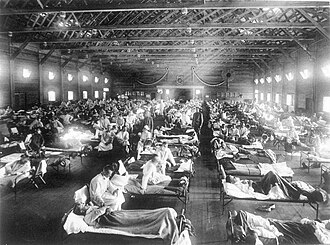
“”Global mobilization of millions of troops meant that the flu spread swiftly, carried from the New World to the old on troopships, and fanning out from ports as far apart as India, Africa and Russia. The war turned the world into a giant petri dish in which the virus could spread and evolve.
|
| —Catharine Arnold, author of the book Pandemic 1918[257] |
The last years of one of history's most devastating wars also brought about one of the worst pandemics in human history, because God apparently didn't think that the situation was quite shitty enough. While the flu pandemic of 1918 is known commonly as the "Spanish Flu", it almost certainly did not originate in Spain. In fact, the earliest known reports of the disease came from Haskell County, Kansas, before it quickly infected at least 500 soldiers at Fort Riley, a major US Army base.[258] From there, the U.S.'s entry into the war brought millions of soldiers to Europe, including many people infected with the virus. So, if it probably came from Kansas (like so many other great things), why is it called the Spanish Flu?
Answer: everybody lied about it. With most of the world embroiled in a struggle to the death, none of their newspapers were permitted by their governments to report on the outbreak, fearing that their enemies would perceive it as an exploitable weakness.[257] The only major neutral power to get hit early on by the pandemic was Spain, which was thus the first to acknowledge it. As a result, basically everyone in Europe and the U.S. collectively decided to start calling it the "Spanish Flu".
This denial of reality, as well as the ongoing war, hampered the world's ability to deal with the flu. For example, British government official Sir Arthur Newsholme refused to take measures like instituting quarantine and shutting down public transport, because he believed focusing on the war effort should claim top priority.[257] While the world was limited to non-pharmaceutical means of controlling the spread of the flu, those engaged in wartime functions were exempt and told to "carry on".[259] The Germans, who were losing the war by then, even briefly considered the pandemic to be a godsend, as it ravaged American and French armies, but then saw their own soldiers fall victim to it as well.[260]

As a result of these factors, the pandemic spread with horrifying speed. Within 18 months of the initial outbreak, about a third of the world's population was infected.[261] The disease came with gruesome symptoms. Sufferers would develop a fever and become short of breath to the point of turning blue. Then hemorrhages filled the lungs with blood and caused catastrophic vomiting and nosebleeds, with victims drowning in their own fluids.[261] This version of the flu was also peculiar, in that it managed to kill off droves of healthy adults between 20 and 40, the cohort usually considered most resistant to the flu.[262] Modern epidemiologists still aren't quite sure why that was the case.
By the last months of 1918, governments and local functions were inundated by the sick. Individual funerals were generally impossible, and many of the dead ended up in mass graves.[261] There are stories of people being buried without coffins, as there were too many to be built.[263] In the U.S., there are stories of public schools being used to hold mass funerals.[264] By the time the illness petered out around 1920, between 50 and 100 million people worldwide had died.[261] Estimates put British dead around 228,000, Americans dead around 675,000, Japanese dead around 400,000, and Indians dead around 12 or 17 million.[261]
Famous people who fell ill from the Spanish flu included U.S. president Woodrow Wilson, future U.S. president Franklin Roosevelt, Kaiser Wilhelm II, Walt Disney, British Prime Minister David Lloyd George, U.S. General John Pershing, Spanish King Alfonso XIII, and Clementine Churchill.[265] Notable fatalities included Donald Trump's grandfather, the Prince of Sweden, Mark Sykes (of Sykes-Picot infamy), Brazilian president Rodrigues Alves, Yakov Sverdlov (Stalin's predecessor as Secretary of the Russian Communist Party), and the eldest son and heir of Ibn Saud of Saudi Arabia.[266]
The October Revolution[edit]

Back in Russia, things started to go even further downhill after the February Revolution. The Provisional Government proved itself little different from the Tsar, being out-of-touch and unwilling to end Russia's participation in the war. Protests resumed in Petrograd and reached 500,000 people by July, with people shouting slogans like "Down with the war!" and "All power to the soviets!"[267]
Speaking of the Soviets, these were originally locally-organized, democratically-elected workers' councils which advocated for leftist political agendas.[268] By this point, though, they felt emboldened enough to form what they called the All-Russian Congress of Soviets in Petrograd to serve as an outright alternative government.[268] Vladimir Lenin also returned from his exile abroad thanks to the efforts of the German Empire, and immediately set about advocating for his own Bolshevik communist politics by writing prolifically and giving speeches whenever he could.[269] Democratically-elected and seemingly sane as they were, the Soviets seemed an enticing alternative to the Provisional Government, especially since they wanted an end to the war.
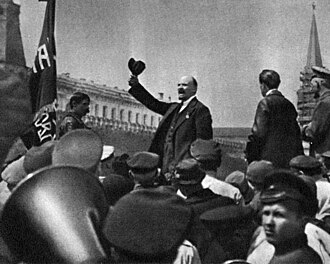
This became distressingly urgent as matters started to seriously deteriorate on the battlefield. The June Offensive, which the Provisional Government hoped would breathe new life into the Russian war effort, was instead a miserable failure that demonstrated that the Russian military had become disorganized and unwilling to fight.[270] The frontline collapsed, and the Russians fell back in disorder.
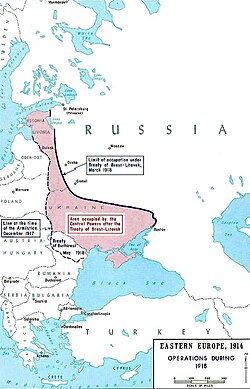
Amid military failures and threats from right-wing reactionaries against the Provisional Government, Lenin urged an immediate coup to place the Soviets in power. One of his worries was also that the Germans might actually seize Petrograd before the leftists even got their chance, since the war was really going that badly.[271] While moderate Bolsheviks like Lev Kamenev and Grigory Zinoviev thought Lenin was being panicky and jumping the gun just a bit, Leon Trotsky won control of the Petrograd Soviet in September and began preparations in line with Lenin's urgings.[271]
Retaliating against a government attempt to shutter a Bolshevik newspaper, Trotsky and his Red Guards launched the October Revolution, a rapid coup that swept the hapless Provisional Government out of power within a day. A Second Congress of Soviets quickly assembled in the wake to determine what to do next. Of its 670 delegates, roughly half opposed the October Revolution due to the coup-like nature of it all, as well as the very real risk that it would spark a civil war.[272] The assembly eventually placed Lenin in charge of drafting a new constitution, which naturally placed himself at the head of the newly-formed Russian Soviet Federative Socialist Republic (RSFSR). Lenin quickly rammed through various decrees, including an immediate ceasefire on all fronts, transfer of land to peasant committees, increased bread supplies to the cities, and the right to self-determination for all ethnic groups in Russia.[273] Most promisingly, he announced that elections would be held for a democratic Constituent Assembly, but he was soon horrified to discover that they failed to produce a Bolshevik party majority.[274] Disillusioned with democracy, Lenin had the body shut down after just one day. No more democracy for Russia.
Outside of the capital and several other Bolshevik-controlled cities, governmental authority in Russia completely broke down. On behalf of the country, Lenin and the Bolsheviks signed the Treaty of Brest-Litovsk with the German Empire, which cost them the support of basically every other Russian factions due to the huge losses of land that the treaty forced on Russia in exchange for peace.[275] Lenin's one-party rule and his hasty agreement to a punishing treaty galvanized opposition to him across Russia, setting the stage for the devastating Russian Civil War.[276]
The end of the War to End All Wars[edit]

Strategic situation in Europe during Germany's final, desperate attacks
Germany's final onslaught[edit]

The United States' entry into the war made the Western Front a hell of a lot more complicated than the German high command hoped it would be. Russia's descent into chaos freed up its soldiers from the East, but the Germans knew that the U.S. would be training and equipping a huge army to cross the Atlantic and smash into German lines. Luckily for the Germans, this would take quite some time. When the U.S. jumped into the conflict, its army had 127,151 soldiers, and the nation had no established process to conscript huge numbers of men, equip them, and send them overseas.[277] The U.S. needed to build more than 30 army training camps and all the infrastructure for them, then find enough equipment to give this army, and then actually fucking train the guys who showed up.[277] This was no easy task, and General John J. Pershing gave his very optimistic goal of having a million men in Europe by May 1918, more than a year after the U.S. joined the war.[277]

That left the Germans with at least all of spring 1918 to spend however they liked until the U.S. showed up. Ludendorff realized the importance of this time frame and began planning a new offensive on the Western Front, one he hoped would be enough of a sucker-punch to knock the Entente out of the war. Russia's fall allowed Ludendorff to redeploy 48 German divisions to the west, and he planned to smash them into the exhausted British, who were smaller in number and theoretically less skilled than the French.[278]
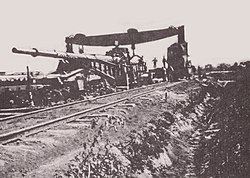
The Germans also learned some lessons from facing Brusilov's new tactics and enduring so many years of attrition warfare. Experiments and innovating throughout the war had led to the creation of the Sturmtruppen or Stoßtruppen, elite soldiers organized into small units and specifically directed against key positions.[279] Armed with grenades, light mortars and machine guns, the Stormtroopers would punch holes in the enemy trench system, cause chaos behind the lines and open the way for a general infantry assault (even after the war, German stormtroopers were considered the legendary elite, hence the rise of the Nazi Sturmabteilung to emulate them some time later).[280]
Ludendorff ordered the first attack on 21 March 1918, advancing over 40 miles[281] and taking 90,000 British prisoners by 5 April.[278] The Germans then fucked up by dispersing their strength to attack in other locations rather than fully exploiting this breakthrough. Instead of knocking out the British, the Germans were distracted by chasing off into Flanders and then trying to punch out the French in May. While the last offensive brought the Germans the closest they had been to Paris since 1914, all it accomplished on the strategic level was creating a salient vulnerable to enemy counter-attack.[278] Being so close to Paris allowed the Germans to bring into play a massive siege cannon to bombard Paris and cause terror.[282] While it was quite impressive in appearance, its shells were small and the huge cannon could only be transported by rail. Sorry, Germany, no wunderwaffe this time.
Germany's spring offensives were ultimately a costly failure. Ludendorff had failed to exploit the breakthroughs he had accomplished, and did no major damage to Entente logistics. Instead, he'd caused about a million extra casualties to German forces in exchange for no strategic benefit.[278] This pushed Germany further towards exhaustion and hastened its collapse.
The Entente strikes back[edit]
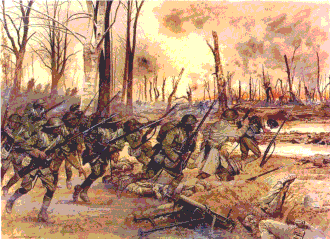
“”The colored people have repeatedly proved their devotion to the high ideals of our country. They gave their services in the war with the same patriotism and readiness that other citizens did.
|
| —U.S. President Calvin Coolidge, 1924[284] |
The U.S. showed up after the German Spring Offensives had exhausted themselves. Fewer than 3,000 American soldiers had been in the field during the spring of 1918,[281] making them pretty damn late to the party. While they were still flooding in, the British kept up the pressure on the Germans by launching the Second Battle of the Marne and the Battle of Bapaume.[285] During this time, American soldiers began serving support functions, which provided a huge boost to Entente morale as their presence promised that backup was coming in force.[286] Also, in June, American marines fought and won the Battle of Belleau Wood against heavy German opposition and hideous casualties.[287] The battle is still revered by the US Marine Corps.
By the late summer of 1918, American divisions began taking up positions on the Western Front. With this infusion of American manpower, the Entente could finally begin their final battle. Starting on August 8, a coordinated offensive began across the front. In the north, the British attacked near Amiens, while in the middle the French attacked the Hindenburg Line and the Americans attacked in the south towards the Argonne in Belgium.[288] Backed up by tanks and airplanes and enjoying a huge numbers advantage, the Entente nations were finally able to push the Germans out of their trenches and truly break the stalemate.
This period, called the Hundred Days Offensive, came at a heavy cost. The Meuse-Argonne Offensive, for instance, was the bloodiest battle in the history of the United States, costing the lives of 26,277 Americans.[289] No battle in the American Civil War or World War II managed to surpass this horrifying number. Altogether, the Entente suffered about 1,070,000 casualties, while the Germans took 1,172,075.[288] German soldiers began surrendering in huge numbers, their positions on the field becoming untenable.
Rapid collapse of the Central Powers[edit]
.jpg)
By mid-1918, all of the Central Powers had a few things in common; the first was absolute misery. The British blockade and the devastation in Russia caused urgent food shortages, escalating malnutrition into mass starvation. The occupation of Ukraine, Europe's breadbasket, did nothing to alleviate this crisis, since the region had been so razed by war.[290] Austria-Hungary and Bulgaria were also together in resenting German control over their military operations and extensive troop presence throughout their countries.
Bulgaria breaks ranks[edit]
Bulgaria was lucky enough to get most of what it wanted out of the war immediately by stomping on its hated enemy Serbia straight out of the gate. After that, the war was pretty pointless for them, with the only meaningful difference for them being the crushing blockade extending to them as well. On top of that, Germany and Austria-Hungary also demanded that Bulgaria contribute garrison forces to occupy Serbia and Romania, further straining the Bulgarian economy and further lowering its manpower reserves.[291]
Entente forces were also able to retreat out of Serbia into neutral Greece, which allowed them to launch harassing offensives into Bulgaria, which the Bulgarians couldn't retaliate against without risking antagonizing the Greeks.[292] This became moot when Greece joined the Entente formally in summer 1917, but skirmishes that Bulgaria couldn't afford then became battles that Bulgaria couldn't afford.
With shortages impacting both civilians and soldiers and news of revolution breaking out in Russia, unrest swept through Bulgaria. Strikes and riots only intensified when the Central Powers signed a treaty to carve up Romania, leaving Bulgaria's territorial objectives completely forgotten.[293] Dick move, bros.
By this point, Bulgaria was done. They signed an armistice on 29 September 1918, becoming the first of the Central Powers to bow out. This was functionally an unconditional surrender, forcing Bulgaria to pull out of occupied territory, demobilize its military, and open itself to occupation by the Entente.[294]
The Ottomans are outta time[edit]
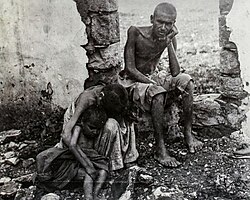
Bulgaria bowing out left the Ottoman Empire in a sticky situation. Its land connection to Germany had been severed, meaning no more aid was coming. British troops occupying Bulgaria under the terms of its armistice were also within striking distance of Constantinople, the empire's capital.[295] Worst of all, these new problems couldn't be dealt with, since Turkish troops were already busy eating shit everywhere else.
Along with the military situation, the Ottomans had also been hobbled for a while by the empire's inability to cope with the demands of a modern war. Since 1915, the Ottoman economy had been unable to provide adequate food for its civilian population, resulting in sweeping famines that year, which only grew worse with every passing month.[296] To deal with this and other shortages, Ottoman authorities allowed for extensive requisitioning from civilians, which local commanders immediately abused to begin looting shit from the people without compensation or receipts.[297] Ottoman policies exacerbated conditions for the Christian population of Lebanon, as their efforts to isolate the minority population prevented food from reaching them and allowed the famine to kill an estimated 200,000 people.[298]
With the Ottomans facing British incursions on every front, and their army down to 15% of what it had been in 1916, the Ottoman government had no choice but to approach the British for armistice.[299] Signed on 30 October, this once again amounted to a total surrender. The Entente got to occupy most of the Ottoman Empire and force open the Dardanelles and Bosporus Straits, while the Ottomans had to demobilize their military and vacate all occupied territory.[294]
This armistice effectively killed the Ottoman Empire. The Young Turks regime collapsed, its leaders having fled to seek refuge in Germany.[300] Law and order broke down across much of the empire, allowing ethnic and religious conflicts to begin spiraling out of control.
Austria-Hungary is heading out[edit]

Austria-Hungary competes with the Ottomans for the title of the most desperately collapsing member of the Central Powers. The death of Kaiser Franz Joseph in 1917 allowed the more reform-minded Karl I to take the throne, but he soon realized that trying to appease the many restless minorities of the empire amid wartime conditions was impossible. Trying to promise autonomy for minority regions of the empire only caused more chaos. Polish and Ukrainian nationalists, for instance, placed claims on the same land in Ruthenia, while the Hungarian part of the empire was enraged that Karl was considering giving autonomy to minorities within Hungarian territory as well.[301]
Meanwhile, food production in Austria-Hungary deteriorated over the course of the war. The more industrial Austrian half of the empire suffered more from this, resulting in the more agrarian Hungarian half being called upon to ship more and more their food to the Austrians.[302] This didn't exactly make the Hungarians happy, and farmers trying to withhold their grain from requisition instead turned to selling on the more profitable black market. By the last two years of the war, food was scarce across the entire empire, and had to be obtained in lengthy bread lines. Riots became common despite brutal suppression by police, and malnutrition allowed epidemics of pneumonia, influenza and dysentery to claim countless victims.[303]
The end for Austria-Hungary came on the Italian front. That woefully inept Italian commander, Cardona, was finally dismissed after the disastrous Battle of Caporetto![]() in late 1917, and was replaced by a competent commander
in late 1917, and was replaced by a competent commander![]() who was able to reorganize the Italian forces and stop using the boneheaded strategies of his predecessor. This led to a turnaround where Italy was more successful in 1918, culminating in the Battle of Vittorio Veneto
who was able to reorganize the Italian forces and stop using the boneheaded strategies of his predecessor. This led to a turnaround where Italy was more successful in 1918, culminating in the Battle of Vittorio Veneto![]() , which ended with the shattered remnants of the Austro-Hungarian army surrendering. As the battle progressed and with encouragement from the Fourteen Points
, which ended with the shattered remnants of the Austro-Hungarian army surrendering. As the battle progressed and with encouragement from the Fourteen Points![]() , portions of the empire began declaring independence from the helpless emperor, starting with Czechia on October 28; Hungary officially broke ties with the Imperial government on October 31. When the battle finally ended on November 3, all that remained of the empire was "German-Austria", which requested an armistice that same day.[294]
, portions of the empire began declaring independence from the helpless emperor, starting with Czechia on October 28; Hungary officially broke ties with the Imperial government on October 31. When the battle finally ended on November 3, all that remained of the empire was "German-Austria", which requested an armistice that same day.[294]
On November 11, 1918, Kaiser Karl issued a proclamation wherein he fired his ministers and announced that he'd allow a constitutional government to be formed... and everyone basically shrugged and took it as an abdication[304]. German-Austria (which would soon drop the "German-" from its name) immediately became a republic; Hungary remained a kingdom but refused to allow Karl on the throne (although that didn't stop him from later trying to take it anyway...).[305] Karl went to his grave (in 1922, from a nasty case of pneumonia) insisting that he hadn't abdicated. Nevertheless, the Austro-Hungarian Empire had officially ended.
The German Revolution[edit]
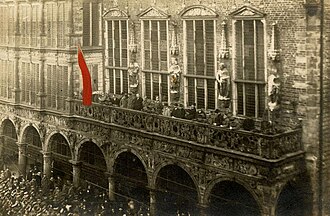
The real factor that broke Germany's back came during the final days. While its military was effective and remained so, its civilians were suffering due to chronic shortages and a rapidly collapsing economy. The winter of 1916-1917 was horrific; German civilians called it the "Turnip Winter", as the potato crop had failed and they were forced to eat turnips instead, which had previously been exclusively used as livestock feed.[306]
Realizing a domestic insurrection was imminent, military leader Erich von Ludendorff pushed to restructure the German Empire into a constitutional monarchy.[307] Ludendorff reasoned that the democratic members of the Entente would be kinder to a more democratic Germany, and that if it was a civilian government that surrendered, the people would blame the politicians rather than the military. That last part was unfortunately quite effective.
Germany's new government opened dialogue with Woodrow Wilson to begin peace talks based on his lenient Fourteen Points plan. Refusing to accept this, German naval commanders planned for one last massive strike against the Royal Navy in hopes of revitalizing the nation's hopes.[308] Instead, sailors at the Kiel naval base mutinied and refused to take part. When the mutineers were arrested, this spiraled into a massive protest involving both sailors and civilians. Protests quickly spread across the country. By November, the revolutionaries had bagged themselves a monarch, forcing the king of Bavaria to flee Germany and proclaiming a "People's State" in his absence.[309] On 9 November, the new German Chancellor Max von Baden announced the Kaiser's abdication, entirely to the Kaiser's surprise.[310] On the advice of Paul von Hindenburg, however, the Kaiser accepted that the loss of his crown was inevitable, and he left for exile in the Netherlands.[310]
After the armistice, Max von Baden found himself unable to negotiate a lasting peace. He resigned and illegally handed the reins to Friedrich Ebert,[310] whose colleague from the German Social Democratic Party, Philipp Scheidemann, went behind his back to declare Germany a republic. Meanwhile, the more radical elements of the Social Democratic Party created the "Spartacus League", led by Karl Liebknecht and Rosa Luxemburg. This kicked off about a year of communist uprisings in Germany, which were eventually put down by the new Republic. Luxemburg and Liebknecht both were assassinated shortly afterwards.[311]
Armistice Day[edit]
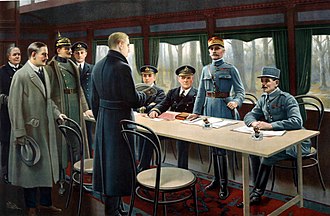
“”At eleven o'clock this morning came to an end the cruellest and most terrible war that has ever scourged mankind. I hope we may say that thus, this fateful morning, came to an end all wars.
|
| —British Prime Minister David Lloyd George, speech to Parliament[312] |
Realizing the military and domestic situation was unsalvageable, the German Chancellor and members of the German Supreme Army Command collectively began encouraging Kaiser Wilhelm to accept peace on the basis of Wilson's Fourteen Points plan, which he had outlined earlier in 1918.[313] The Germans bickered amongst themselves while the Entente suddenly faced the problem that the Germans actually expected peace to resemble the relatively lenient Fourteen Points. According to historian Ferdinand Czernin:[314]
“”The Allied statesmen were faced with a problem: so far they had considered the "fourteen commandments" as a piece of clever and effective American propaganda, designed primarily to undermine the fighting spirit of the Central Powers, and to bolster the morale of the lesser Allies. Now, suddenly, the whole peace structure was supposed to be built up on that set of "vague principles", most of which seemed to them thoroughly unrealistic, and some of which, if they were to be seriously applied, were simply unacceptable.
|
Meanwhile, Germany only seriously decided to come to the table after being forced to by the onset of the German Revolution. The armistice negotiations were hurried, and Germany had very little input into what it actually entailed beyond correcting a few demands which were physically impossible. The Kaiser's abdication convinced the German delegation to simply sign whatever piece of paper was in front of them and be done with it.[315] The armistice itself famously went into effect "on the eleventh hour of the eleventh day of the eleventh month."[316]
Aftermath and legacy[edit]
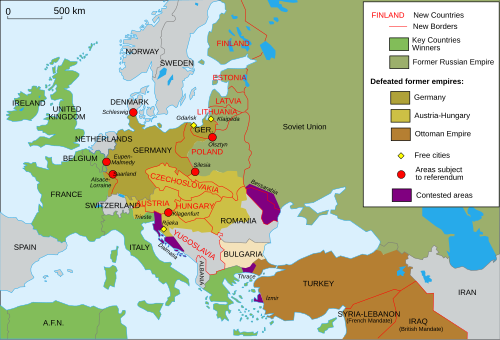
“”This is not peace. It is an armistice for 20 years.
|
| —Marshal Ferdinand Foch, 20 years and 65 days before World War II began[317] |
Remaking the world map[edit]
There were a colossal number of peace treaties required to officially end the war (16 in total),[318] which collectively reconfigured the political and territorial landscapes of not only Europe, but also other parts of the world, especially the Middle East.
Treaty of Brest-Litovsk (1918)[edit]
The first peace treaty came as a result of the Russian Revolution. After two months of negotiations, the Bolsheviks agreed to a harsh loss of territory from the Soviet Union, much of which was intended to have become a series of German satellite states. Among the areas ceded were the Baltic states, which would have become puppets of Germany, a chunk of the Caucasus, which would have gone to the Ottomans, and Ukraine.[319] Although it was annulled by the armistice between Germany and the Entente, it did have some important implications for the future. It caused an angry increase in Polish nationalism, as Russian Poland was not mentioned in the treaty, and it was assumed that the region would either be annexed by Germany or become a puppet state.[320] It also gave the Bolsheviks an important boost by both giving them credit for ending the war and giving them time to consolidate their hold over Russia. Lenin argued that the territorial losses would be temporary, as he assumed that the German Revolution would result in a socialist state there, which would hand the territories back to Russia.[321] Finally, when Germany protested that the later Treaty of Versailles was too harsh, the Entente rightly retorted that the Germans had enforced much harder terms on the Russians.[322]
As for the reshuffled map of Eastern Europe, those borders were settled through a series of bloody wars.
Treaty of Versailles (1919)[edit]
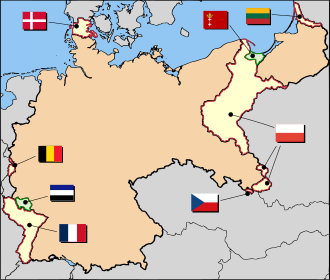
Probably the most infamous of the postwar treaties, the Treaty of Versailles resulted from disagreement between the various Entente powers. Woodrow Wilson's Fourteen Points plan, favored by the Germans, was discarded by the other powers because most of the Entente not only demanded compensation from Germany for their wartime suffering, but had also made secret treaties with other countries as to how Germany would be split up.[323] As a result, the United States was sidelined while Britain, France and Italy pecked at Germany's corpse. The Germans were shocked by the treaty's terms, as they had been assured a relatively soft peace in return for the armistice.[323]
Germany was forced to cede Alsace-Lorraine back to France, allow the Saarland to be placed under military occupation, cede some areas to Belgium, cede northern Schleswig to Denmark, cede parts of Silesia and West Prussia to the resurrected Poland, and lose its colonial holdings to France, the United Kingdom, and Japan.[323] Germany was then forced to demilitarize. There was also a "war guilt" clause that declared Germany as the primary aggressor in the war and made them responsible for paying reparations to the Entente powers. This last part caused much anger among the Germans, but the Entente powers subsequently agreed to lessen and then indefinitely postpone the payments.[324]
In the end, the treaty was neither lenient enough nor harsh enough to prevent another war. Germany was not pacified by a light-handed peace, nor was it weakened enough by the territorial losses inflicted upon it. The Entente powers themselves realized that the agreement had problems. British representative John Maynard Keynes predicted that the treaty's reparations clause would inflame German revanchism, while French Marshal Ferdinand Foch criticized the treaty for treating Germany too leniently.[325]
Treaty of Saint-Germain (1919)[edit]
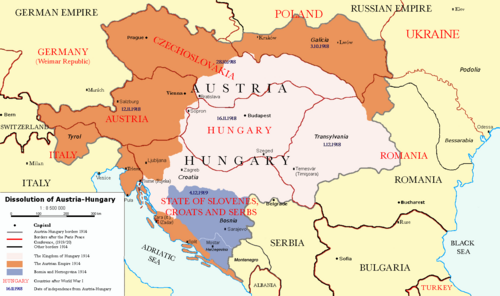
Signed in 1919, this treaty dismantled the Austria-Hungarian Empire. Austria was forced to release Czechoslovakia and Hungary as independent states, cede Galicia to Poland, and cede various territories to Italy and Yugoslavia.[326] Despite its relative obscurity, this became one of the more problematic of the post-WWI treaties. First, the Entente had an "uh-oh" moment when they realized that they had promised the same territories (Dalmatia and Istria) to both Italy and Yugoslavia.[327] Wanting to contain Italy's imperial ambitions (and frustrated by their intransigent demands for land), the Entente only agreed to give them part of Dalmatia and the port of Trieste. Angry and unhappy with this result (the "mutilated victory"), Italy's government all but collapsed, creating the perfect opportunity for Benito Mussolini to begin his political rise.[328] Additionally, there was the problem that the Sudetenland went to Czechoslovakia, which would be one of the factors abused by Adolf Hitler during the lead-up to World War II.
The new republican Austria was politically unstable and militarily weak, and would be a source of stress between the Central European powers for most of the interwar period.[329][330] Austrian politicians popularly believed that an Austrian state stripped of its empire would not be able to survive on its own, and the concept of union with Germany started to become extremely popular within the nation, despite such an act having been specifically forbidden by the Saint-Germain terms.[331] This would also cause some problems later on.
Treaty of Trianon (1920)[edit]
After tearing apart Austria, the Entente powers set upon the newly-independent Hungary as well in 1920. Hungary was an absolute trainwreck after its independence, spiraling from a republic into a communist state into a series of wars with Romania, Yugoslavia and Czechoslovakia, and then becoming an unstable republic again.[332] Hoping to resolve the violence, the Entente decided to cut Hungary's territory by about two-thirds, forcing them to cede much of their southern territory to Yugoslavia, cede Transylvania to Romania, and recognize Czechoslovakia's ownership of Slovakia and part of Ruthenia.[333]
The treaty inflamed ethnic resentment among Hungarians, as they had lost territories that had been Hungarian for centuries. Landlocked and surrounded by enemies, Hungary saw its economy collapse.[334] This contributed to political radicalism in Hungary, and Hitler would subsequently return parts of Hungary's lost land as a means of bribing them into joining the Axis.[334]
Treaty of Sèvres (1920) and the new Middle East[edit]
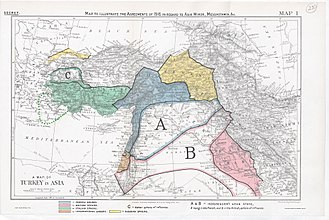
Shortly after Trianon, the Entente signed the Treaty of Sèvres to put the Sick Man of Europe out of his misery. This treaty was very harsh, forcing the Turks to renounce basically all land that wasn't majority Turkish.[335] The rest of the empire was partitioned between Britain and France alone, as Russia was too busy doing other shit and the U.S. had gone back into isolationism. The partitioning of the Middle East was decided under the terms of the much-discussed Sykes-Picot Agreement of 1916, which had been conducted in secret between British and French diplomats. Under the terms of the agreement, France would take Syria, Lebanon and a chunk of Anatolia, while the British would take Iraq, Jordan and Palestine.[336]
The major point here was that the UK and France's plans for the postwar Middle East amounted to a heartlessly dishonorable betrayal of its wartime Arab allies, whom the Entente supported in their rebellion against the Ottoman Empire. They promised to support the existence of an independent Arab nation-state in return for Arab cooperation against the Ottomans, but the British and French governments had already decided to turn the region into a series of colonies instead.[337] Anti-colonial rebellions against the new peace were suppressed with deadly force.
Perhaps worst of all, though, was the fate of Britain's chief former ally, the Sharif Hussein bin Ali of the Hashemite dynasty. He refused to accept British control over Palestine and was thus abandoned to the dogs by the angry British.[338] As a result, Hussein was unable to survive against his rivals, the radical Ikhwan forces led by the House of Saud, who followed the Wahhabi interpretation of Sunni Islam.[338] The British backstabbing of Hussein directly resulted in the rise of Saudi Arabia, a terrorist state which has plagued the world for decades.
Ultimately, the Treaty of Sèvres upheld the provisions of the Sykes-Picot betrayal by declaring British and French rights to their claimed areas of influence in the Middle East, allowing them to carve out colonial occupation regimes there at their leisure.[336] The British also formed the Iraq Petroleum Company to give themselves almost exclusive rights to drill for oil on Iraqi territory.[339]
Treaty of Lausanne (1923)[edit]
While the Middle East was successfully carved up under Sèvres, the Entente started to realize the pool was a bit deeper when it came to Anatolia. After the mutilated Ottoman government was forced to sign the humiliating treaty, nationalist officers like Mustafa Kemal Ataturk revolted against the terms. While the loss of the empire was an acceptable loss, Ataturk and his comrades were horrified that the Entente (including the hated Greeks) wanted to occupy Anatolia itself and leave Turkey as a rump state in just the northern bit.[340]
Nationalist forces under Ataturk usurped the Ottoman government and formed the Republic of Turkey and then fought the Turkish War of Independence. After a huge victory over the Greeks at the Battle of Sakarya in 1921, the nationalist movement gained international credibility and proved that Anatolia wasn't going to be occupied as easily as the Arab Middle East had been.[341] Finally recognizing that their aims in the region were impossible, the Entente got back together and signed the 1923 Treaty of Lausanne as a final settlement for the Turkish people in Anatolia.[342] The Treaty, while confirming British and French domination over the Middle East, preserved Turkish territory within Anatolia and allowed it to be a free and neutral nation. Ataturk had defeated colonialism.
No peace in the East[edit]
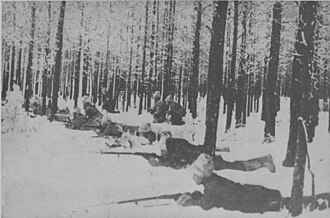
The Russian Civil War (1918-21)[edit]
As a direct consequence of the October Revolution, central authority in Russia completely dissolved, leaving the question of who would control the country's destiny an open question which could only be resolved through bloodshed. On the one hand, Vladimir Lenin and Leon Trotsky led the Reds, while an ideologically broad anti-Bolshevik faction became the Whites. The war drew in the different nations inside the Russian Empire, and outside nations such as the United States and United Kingdom intervened militarily in an attempt to prevent the communist takeover of Russia.[343]
Also, on 17 July 1918, the Bolsheviks executed ex-Tsar Nicholas II and his entire family, including his young daughters.[344] They had been in exile after the revolutions, and the murders ensured that Russia would never return to monarchist rule.
The war was exceptionally brutal. The Red secret police, the Cheka, 8,500 summary executions during the war, and they arrested and tortured many more.[345] Lenin also issued the infamous "hanging order" in which he demanded that 100 Ukrainian dissidents be hanged publicly and then their villages' food stores confiscated.[346] The Whites also brutalized and mass killed socialists, communists, and especially Jews.[347]
Finnish Civil War (1918)[edit]
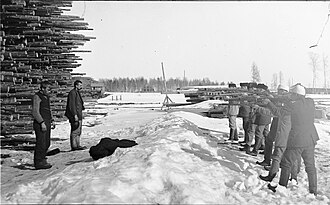
Finland similarly erupted into civil war as downtrodden Finnish workers rose up, only to be opposed by right-wing paramilitaries, many of which had been trained by Germany.[348] The Whites controlled the rural north while the Reds controlled the large southern cities with their working-class populations.[349]
Although outnumbered, the Whites were led by Carl Gustaf Emil Mannerheim, an aristocratic cavalry general who had gained firsthand combat experience during the world war, and his leadership proved to be a decisive factor.[350] Both sides, like in Russia, committed acts of terror and atrocity upon civilians and prisoners. The White Terror, being conducted with the Whites having the upper hand in the war, featured lawless field court-martials, take-no-prisoners policies, and bloody reprisals, resulting in the murder of some 10,000 people.[348]
Although the Whites emerged victorious, they did so at the head of a devastated nation towards which 40% of the Finnish population no longer felt any loyalty.[349]
Soviet westward offensives (1918-19)[edit]
The newly-formed Russian Soviet Federative Socialist Republic, while fighting in a desperate civil war, still had ambitions of reuniting the massive Russian Empire under its new ideology. Multiple nations, such as Estonia and Lithuania, had taken advantage of the chaos and broken away from their Russian overlords. As German forces withdrew from Eastern Europe following the armistice, the Soviets surged forward in an attempt to occupy these breakaway regions for themselves. They were also operating on the theory that all nations had a discontented majority of working class people who would rise up to assist a communist invasion. As you can imagine, this ended up not being true.
Estonian and Latvian forces fought together side-by-side with both German and British support and exiled White Russian forces.[351] By 1920, the Soviets were forced to acknowledge the independence of the Baltic nations.
Polish-Soviet War (1919-21) and the Miracle on the Vistula[edit]

Poland had not existed as an independent country since 1795, when it was carved up between Prussia, Russia, and Austria.[352] The Poles had long dreamt of fixing this, and the 1919 Treaty of Versailles finally granted them this independence. Unfortunately, the Reds had something to say about that.
Lenin wanted to spread his communist ideology as far as possible, and Germany at the time was undergoing a major leftist uprising, so he viewed it as a critical priority to unite the two revolutions.[352] Poland stood between them, and it was very much not a communist nation. Józef Piłsudski, the leader of Poland, noted that his country didn't have a fully defined eastern border, and he furthermore had ambitions of forming a power bloc with the Baltic states and Ukraine to resist any future Russian or German aggression.[352]
Poland attacked first, aware of Soviet Russia's ambitions towards them and believing that the Russian Civil War had made them a soft target.[353] Unfortunately for them, the Soviets were fully able to push back, and Poland's lines collapsed.
By summer 1920, the Poles had been pushed all the way back to the outskirts of Warsaw on the Vistula River. Facing the real possibility of national destruction, the Poles desperately employed code-breakers to determine the positions of the Soviet forces, and a counterattack was able to drive the Russians back by encircling one of their armies.[354] This "Miracle on the Vistula" preserved Poland's independence (until World War II).
The war's human cost[edit]
German soldiers were killed at the rate of one every 45 seconds, and French death rates were even higher. In the five months during which the battles of Verdun (February 18 to December 21) and the Somme (July 1 to November) were waged in 1916, nearly a million men died, an average of 6,600 every day, more than 277 every hour, nearly 5 every minute. During the largely concurrent Brusilov Offensive (early June to late September), nearly 1,600,000 men died, or approximately 9 every minute. This was not exceptional; as Martin Gilbert pointed out, the 20,000 British soldiers killed on the first day of the Somme are often recalled with horror, yet on average, a similar number of soldiers died during every four-day period of the entire war.[355] French casualties from the First World War were greater than American casualties from every war that the U.S. has ever taken part in.[note 1] Russia and Germany each suffered even greater casualties. However, the greatest losses per capita were those of Serbia, which lost somewhere between a sixth![]() and a quarter
and a quarter![]() of its pre-war population, a rate at least double that of the second hardest hit population (Romania's).
of its pre-war population, a rate at least double that of the second hardest hit population (Romania's).
Hardship on the Home Front[edit]
Curtailment of civil liberties[edit]
.jpg)
The initial enthusiasm for war (at least in certain segments of the populations) had initially put some of the internal tensions in the warring states to rest. Regardless, civil liberties were quickly curtailed, even before the grinding war effort produced widespread dissatisfaction.
In the United Kingdom[edit]
The Defence of the Realm Act (DORA)![]() curtailed freedom of speech and extended the government's ability to confiscate or control resources and property it regarded as necessary for the war effort (further strengthened by the Munitions of War Act 1915
curtailed freedom of speech and extended the government's ability to confiscate or control resources and property it regarded as necessary for the war effort (further strengthened by the Munitions of War Act 1915![]() ).
).
In the United States[edit]
World War I saw a massive propaganda campaign (run by the grandaddy of PR, Edward Bernays) and an all-out government attack on civil liberties by Woodrow Wilson. The Espionage Act of 1917 and the Sedition Act of 1918 made it illegal to speak out against the war in any significant way.[356] Citizen groups carried out vigilante actions against those considered "un-American", including Americans of German descent, such as Hutterites, Pennsylvania Dutch, and Yiddish-speaking Jews. People were forced to support the war vocally and financially by various "citizens groups" who could report others for disloyalty for not buying war bonds and giving other material support. Among those who were sent to jail for opposing the war and/or conscription were Eugene V. Debs (10-year sentence) and Emma Goldman (two-year sentence). The Supreme Court also upheld the government's ability to curtail speech during wartime with the Schenck v. United States case.
Myths about the war[edit]
- The U.S. was entirely neutral until 1917 — Woodrow Wilson privately supported the Allies from the onset of the war. American businesses supported the Allies with materiel, but not Germany, due to a naval blockade.[231][357]
- Opponents to war were isolationists — Many opponents were in fact peace supporters and/or internationalists.[231][357]
- Opposition dissolved once the U.S. declared war — A rally of 15,000 in New York City opposed the war in 1917 despite police intimidation. The precursor of the ACLU was formed at this time to defend opponents of the war who were exercising their free speech rights.[231][357]
- African Americans eagerly supported the war — While some prominent African American leaders did support the war, the support was far from universal, particularly because of troop segregation and the lack of full democracy for African Americans.[231][357]
- The new conscription law was widely obeyed — Resistance to conscription was strong: 3 million of 27 million eligible men did not register, and 338,000 of the registered either failed to obey induction orders or deserted.[231][357]
World War I in popular culture[edit]

“”In Flanders fields the poppies blow,
Between the crosses, row on row |
| —"In Flanders Fields", by John McCrae[358] |
The years following the end of the war were marked by an almost unparalleled number of monuments being erected in both Europe and the United States to those who fought and those who died in the carnage. In the U.S., perhaps only the Civil War has produced more memorials than WWI. One particular statue, The Doughboy![]() by sculptor E.M. Viquesney, is believed to have over 200 castings throughout America, despite Viquesney claiming to have produced around 300 of them.
by sculptor E.M. Viquesney, is believed to have over 200 castings throughout America, despite Viquesney claiming to have produced around 300 of them.
The legendary football match said to have taken place in 1914 during a Christmas truce between German and British forces is one of the most iconic images of World War I,[359] and was later used as the basis of the video for Paul McCartney's song "Pipes of Peace", as well as John McCutcheon's ballad "Christmas in the Trenches". The war also remained alive through the rock n' roll era in songs such as the Zombies' "The Butcher's Tale (Western Front, 1914)".
In Germany, the war produced two rather different bestsellers, one fictional and anti-war, the other (somewhat) autobiographical and with an emphasis on the "ennobling" aspects of the war experience. The former, and the better known internationally, was Erich Maria Remarque's All Quiet on the Western Front![]() (1929), which (unsurprisingly) was not well-received by the Nazis and other right-wing groups. In fact, it was one of several books that the Nazis burned upon coming into power in 1933. The latter was Ernst Jünger's Storm of Steel
(1929), which (unsurprisingly) was not well-received by the Nazis and other right-wing groups. In fact, it was one of several books that the Nazis burned upon coming into power in 1933. The latter was Ernst Jünger's Storm of Steel![]() (1920), which was far more suited to Nazi tastes (however, it should be noted that Jünger published some quite different versions of the book and was no admirer of Nazism, despite being a radical right-winger). Both books were written by men with personal but quite divergent experiences of WWI: Remarque had spent 1½ months at the Western Front as an 18-year-old conscript in 1917 before being wounded and spending the rest of the war in a hospital. Jünger, in contrast, had volunteered at the age of 19 in 1914 (after having briefly served in the French Foreign Legion prior to the war), advanced from private to lieutenant, was wounded 14 times during the war and finally received the highest award for bravery in the German Empire, the Pour le Mérite. All Quiet on the Western Front was adapted for the big screen several times, the first time in 1930 by Universal Studios, then led by German-born Carl Laemmle, Sr. This version won two Academy Awards, among them the one for best director, and was nominated for two more.
(1920), which was far more suited to Nazi tastes (however, it should be noted that Jünger published some quite different versions of the book and was no admirer of Nazism, despite being a radical right-winger). Both books were written by men with personal but quite divergent experiences of WWI: Remarque had spent 1½ months at the Western Front as an 18-year-old conscript in 1917 before being wounded and spending the rest of the war in a hospital. Jünger, in contrast, had volunteered at the age of 19 in 1914 (after having briefly served in the French Foreign Legion prior to the war), advanced from private to lieutenant, was wounded 14 times during the war and finally received the highest award for bravery in the German Empire, the Pour le Mérite. All Quiet on the Western Front was adapted for the big screen several times, the first time in 1930 by Universal Studios, then led by German-born Carl Laemmle, Sr. This version won two Academy Awards, among them the one for best director, and was nominated for two more.
The 1981 film Gallipoli, named after the campaign of the same name, reminded many people (many of whom didn't need to be reminded) of the pointless waste of human life that accompanied much of the action in the war.[360]
The main character in Charles Todd's series (1996–2008) of British village murder mysteries, Inspector Ian Rutledge, is a shell-shocked veteran of the trenches, who is always accompanied (at least in his mind) by a Scottish soldier that he was compelled to execute.
The fourth and final series of the BBC One sitcom Blackadder was set in a trench during World War I. Breaking from the show's usual comedic tone, it featured many truths and poignant moments regarding life in the trenches, and has also become something of a punching bag/straw man for those, such as Michael Gove, who prefer a more "glorious" British WWI narrative.[361]
The comedy Oh! What a Lovely War (very loosely) tells the story of the war using British Army songs and fanciful scenes of recruiting. It originated as a radio script by Charles Chilton in 1961, was adapted for the stage by Theatre Workshop in 1963, then became a very successful film directed by Richard Attenborough in 1969.
In 2016, EA DICE released Battlefield 1, an FPS based on the first war. The game was very well-received, a surprise for both developer and gamer. The plot, unlike the rest of the series, is told in a series of personal vignettes, with the deaths of soldiers treated with the utmost respect, particularly in the prologue.
In 2019, the film 1917 was released, directed by Sam Mendes. The film was shot in a way to make it look like all of it was done in a single take, with its cinematographer, Roger Deakins, winning an Academy Award for his work.
See also[edit]
- World War II
- World War III
- Scramble for Africa — African colonialism was a major expression of the 19th-20th century imperialism that led Europe to war.
- German Empire
- Iran-Iraq War — Trench warfare is back, baby!
- Yugoslav Wars — another damned foolish thing in the Balkans.
- Armenian Genocide denial
External links[edit]
- The Great War, a video-based wealth of WWI information presented by historian Indy Neidell
- Remembering The Great War: The Outbreak, Popular Science
- A global guide to the first world war - interactive documentary, The Guardian
- Over There!
Videos by History Matters[edit]
- The Anglo German Naval Arms Race
- Why didn't Spain join World War One?
- Why didn't Belgium let the German through in World War One?
- Why didn't Germany invade the Netherlands in World War One?
- Why Did the Ottoman Empire Join the Central Powers?
- Why didn't Italy join the Central Powers in World War One?
- Why did the US Join World War One?
- How did Mexico React to the Zimmerman Telegram?
- How Harsh was the Treaty of Versailles Really?
- Why didn't Belgium get more land after World War One?
- Why Was Hungary Punished So Severely After World War One?
- What did Kaiser Wilhelm do After His Abdication?
Further reading[edit]
For an overview of the entire WWI, including its origins and aftermath, interspersed with thematic sections on various subtopics:
- Meyer, Gerald J (2006). A World Undone: The Story of the Great War 1914 to 1918. Random House. ISBN 978-0-553-80354-9.
For works on the origins of WWI (the first being of the "slide towards war" school, the latter more middle of the road):
- Clark, Christopher
 (2013). The Sleepwalkers: How Europe Went to War in 1914. HarperCollins. ISBN 978-0-06-219922-5.
(2013). The Sleepwalkers: How Europe Went to War in 1914. HarperCollins. ISBN 978-0-06-219922-5. - MacMillan, Margaret
 (2013) The War That Ended Peace: How Europe Abandoned Peace for the First World War. London: Profile Books. ISBN 9781846682728.
(2013) The War That Ended Peace: How Europe Abandoned Peace for the First World War. London: Profile Books. ISBN 9781846682728. - Possibly the best known work on the topic remains Barbara Tuchman’s
 1962's The Guns of August,
1962's The Guns of August, but while it is well written and entertaining it is both dated and contains problematic elements such as internal monologues and guesses at motives and obvious national and sexual stereotyping, rendering it less useful at a source of accurate information.
but while it is well written and entertaining it is both dated and contains problematic elements such as internal monologues and guesses at motives and obvious national and sexual stereotyping, rendering it less useful at a source of accurate information.
As for the aftermath of WWI with particular emphasis on the negotiations that resulted in the various peace treaties:
- MacMillan, Margaret (2001) Peacemakers: The Paris Peace Conference of 1919 and Its Attempt to End War,
 John Murray. ISBN 0-7195-5939-1 (republished in 2003 as: Paris 1919: Six months that changed the world. Random House. ISBN 9780375760525)
John Murray. ISBN 0-7195-5939-1 (republished in 2003 as: Paris 1919: Six months that changed the world. Random House. ISBN 9780375760525)
For WWI on the Eastern Front, Prit Buttar![]() has written a series of four books that chronologically cover this theatre in detail:
has written a series of four books that chronologically cover this theatre in detail:
- The Splintered Empires: The Eastern Front 1917-21. 2017. Osprey Publishing. ISBN 9781472819857
- Russia's Last Gasp: The Eastern Front 1916-17. 2016. Osprey Publishing. ISBN 147281276X
- Germany Ascendant: The Eastern Front 1915. 2015. Osprey Publishing. ISBN 9781472807953
- Collision of Empires: The War on the Eastern Front in 1914. 2014. Osprey Publishing. ISBN 9781782006480
The Italian front as well as its intertwined political and especially cultural developments are treated in depth (though mainly from an Italian perspective) by:
- Thompson, Mark
 (2008) The White War: Life and Death on the Italian Front, 1915–1919. London: Faber and Faber. ISBN 0-465-01329-5.
(2008) The White War: Life and Death on the Italian Front, 1915–1919. London: Faber and Faber. ISBN 0-465-01329-5.
The Africa theatre of WWI is not particularly well covered in the more popular literature, but this book is worth a read:
- Gaudi, Robert (2017) African Kaiser: General Paul von Lettow-Vorbeck and the Great War in Africa, 1914-1918. C Hurst & Co Publishers Ltd. ISBN 9781849048675
Notes[edit]
- ↑ Which puts all claims of French cowardice to bed, especially considering that America's bloodiest war was the one it spent fighting itself.
References[edit]
- ↑ "Goodbyeee", Blackadder Goes Forth
 (1989)
(1989)
- ↑ See the Wikipedia article on The war to end war.
- ↑ World War One: Killed, wounded, and missing. Britannica.
- ↑ 1918 Pandemic (H1N1 virus). Centers for Disease Control.
- ↑ World War 1 casualties.
- ↑ Sykes-Picot Agreement. Britannica.
- ↑ The Hashemite saga and the tragedies of Arab history. Khaleej Times.
- ↑ Failed Peace: The Treaty of Versailles, 1919. HistoryNet.
- ↑ Entry from the diary of Georg Alexander von Müller. Bundesarchiv-Militärarchiv, Freiburg.
- ↑ The debate on the origins of World War One, The British Library
- ↑ World War One: 10 interpretations of who started WW1, BBC News
- ↑ Why Did World War I Happen? Council on Foreign Relations. April 14, 2023.
- ↑ Dr Michael Rowe, [https://www.kcl.ac.uk/the-franco-prussian-war-150-years-on The Franco-Prussian War 150 years on: A conflict that shaped the modern state]. King's College London. 17 July 2020.
- ↑ Balkan Wars 1912-1913. By Richard C. Hall. International Encyclopedia of the First World War.
- ↑ The Great Powers and the "Eastern Question", MSU
- ↑ British Foreign Policy - Splendid Isolation - 1860-1905. GlobalSecurity.
- ↑ The Russo-German Reinsurance Treaty (1887). Alpha History.
- ↑ ‘Dulce et Decorum est’ & intertextuality in Wilfred Owen. The Poetry Society.
- ↑ 19.0 19.1 Nationalism as a cause of World War I. Alpha History.
- ↑ The Beginning of World War I. Facing History.
- ↑ Karl Pearson's The Problem of Practical Eugenics. University of Missouri.
- ↑ 1914: War or Peace? Facing History.
- ↑ The soldiers across Europe who were excited about World War I. The Conversation.
- ↑ 24.0 24.1 Never Forget That World War I Was Also Racist. Foreign Policy.
- ↑ 14-18, Understanding the Great War. By Stéphane Audoin-Rouzeau, Annette Becker.
- ↑ MacMillan, Margaret (2013). The War That Ended Peace: The Road to 1914. Random House. ISBN 978-0-8129-9470-4. p524
- ↑ Schubert, Michael (2011). "The 'German nation' and the 'black Other': social Darwinism and the cultural mission in German colonial discourse". Patterns of Prejudice. 45 (5): 399–416. doi:10.1080/0031322x.2011.624754. S2CID 143888654.
- ↑ Race, racism and military strategy. British Library.
- ↑ Militarism as a cause of World War I. Alpha History.
- ↑ Naval Race between Germany and Great Britain, 1898-1912. International Encyclopedia of the First World War.
- ↑ The London Naval Conference, 1930. US State Department.
- ↑ Who Gained More From the Dual Alliance: Germany or Austria-Hungary?. James Snell. Cambridge historian.
- ↑ Triple Alliance. Britannica.
- ↑ Moroccan crises. Britannica
- ↑ Entente Cordiale. Britannica.
- ↑ [1]. New World Encyclopedia.
- ↑ 37.0 37.1 Congress of Berlin. Britannica.
- ↑ https://encyclopedia.1914-1918-online.net/article/bosnian_crisis Bosnian Crisis. By Marc Stefan Peters. International Encyclopedia of the First World Ward.
- ↑ On the Brink, The New York Times
- ↑ Assassination of Archduke Ferdinand, 1914. Eyewitness to History.
- ↑ 41.0 41.1 Plotters Decide to Kill the Archduke. Mentalfloss.
- ↑ See the Wikipedia article on Young Bosnia.
- ↑ Black Hand. Britannica.
- ↑ 44.0 44.1 44.2 WWI Centennial: Archduke Ferdinand Is Murdered in Sarajevo. Mentalfloss.
- ↑ Willmott, H.P. (2003). World War I. New York: Dorling Kindersley. ISBN 978-0-7894-9627-0. OCLC 52541937. p. 26
- ↑ Sarajevo Incident. International Encyclopedia of the First World War.
- ↑ The First World War by John Keegan (1999) Pimlico. ISBN 0712666451.
- ↑ Austrians Decide on War With Serbia. Mentalfloss.
- ↑ Germany Gives Austria-Hungary a “Blank Check”. Mentalfloss.
- ↑ The Ultimatum Plan. Mentalfloss.
- ↑ 51.0 51.1 51.2 51.3 Austria-Hungary Rejects Serbia’s Response. Mentalfloss.
- ↑ Austria-Hungary Declares War on Serbia. Mentalfloss.
- ↑ See the Wikipedia article on The lamps are going out.
- ↑ Strachan, Hew (2003). The First World War: Volume I: To Arms. New York: Viking. ISBN 978-0-670-03295-2. OCLC 53075929. p. 292–296, 343–354.
- ↑ Radomir Putnik. Britannica.
- ↑ Disaster on the Drina: The Austro-Hungarian Army in Serbia, 1914. Schindler, John R. (1 April 2002).
- ↑ Alfred von Schlieffen. Britannica.
- ↑ Schlieffen Plan. Britannica.
- ↑ 59.0 59.1 Helmuth von Moltke. Britannica.
- ↑ The World War One German invasion of Belgium… What happened next?. History is Now.
- ↑ The German Army Marches Through Brussels, 1914. Eyewitness to History.
- ↑ The Rape of Belgium. by Mike Shuster. The Great War Project.
- ↑ The ‘German Atrocities’ of 1914. Sophie de Schaepdrijver. British Library.
- ↑ See the Wikipedia article on Rape of Belgium.
- ↑ High Voltage Fence (The Netherlands and Belgium). By Alex Vanneste. International Encyclopedia of the First World War.
- ↑ Kossmann, E. H. (1978). The Low Countries, 1780–1940. Oxford History of Modern Europe (1st ed.). Oxford: Oxford University Press. ISBN 978-0-19-822108-1. p. 533–4.
- ↑ 67.0 67.1 Hard Truths about Britain’s Entry into World War I. History News Network.
- ↑ First world war: how the Manchester Guardian fought to keep Britain out of conflict, The Guardian
- ↑ See the Wikipedia article on Anglo-Japanese Alliance.
- ↑ O'Neill, Robert (1993). "Churchill, Japan, and British Security in the Pacific 1904–1942". In Blake, Robert B.; Louis, William Roger (eds.). Churchill. Oxford: Clarendon Press. p. 276. ISBN 978-0-19-820626-2.
- ↑ 71.0 71.1 71.2 Japan. International Encyclopedia of the First World War.
- ↑ See the Wikipedia article on Siege of Tsingtao.
- ↑ Twenty-one Demands. Britannica.
- ↑ 74.0 74.1 Tannenberg, Battle of. International Encyclopedia of the First World War.
- ↑ See the Wikipedia article on Battle of Tannenberg.
- ↑ See the Wikipedia article on First Battle of the Masurian Lakes.
- ↑ See the Wikipedia article on Battle of Grunwald.
- ↑ See the Wikipedia article on Gorlice–Tarnów Offensive.
- ↑ The Schlieffen Plan. Alpha History.
- ↑ Charles Lanrezac. Britannica.
- ↑ Charleroi, Battle of. International Encyclopedia of the First World War.
- ↑ The Battle of Lorraine, 1914. firstworldwar.com
- ↑ Battle of Lorraine, 14 August-7 September 1914. History of War.
- ↑ 84.0 84.1 Battle of the Marne: 6-10 September 1914. BBC History.
- ↑ 85.0 85.1 The First Battle of the Marne. ThoughtCo.
- ↑ The First Battle of the Aisne, 1914. firstworldwar.com
- ↑ Race to the Sea. firstworldwar.com.
- ↑ Trench warfare. Britannica.
- ↑ History of Trench Warfare in World War I. ThoughtCo.
- ↑ World War I: The Christmas Truce of 1914. ThoughtCo.
- ↑ Turkey Joins the War.
- ↑ The Jihad Legacy of World War I. Wolfgang G. Schwanitz. Foreign Policy Research Institute.
- ↑ The Berlin-Baghdad Express: The Ottoman Empire and Germany's Bid for World Power, 1898-1918 by Sean McMeekin. The Guardian.
- ↑ 94.0 94.1 94.2 Jihad, Holy War. International Encyclopedia of the First World War.
- ↑ History on the Tracks: The Berlin-Baghdad Railway. Pacific Standard.
- ↑ Pergamonmuseum. Staatliche Museen zu Berlin.
- ↑ Lüdke, Tilman (2016). Jihad and Islam in World War I. Leiden University Press. pp. 71–72. ISBN 9789087282394.
- ↑ Ottoman Empire enters the First World War. New Zealand History.
- ↑ Naval Operations. Turkey in the First World War.
- ↑ Shaykh Al-Islām. Encyclopedia.com
- ↑ See the Wikipedia article on Bergmann Offensive.
- ↑ Battles - The Capture of Basra, 1914. Worldwarone.com
- ↑ What You Need To Know About The British Naval Blockade Of The First World War. Imperial War Museum.
- ↑ How Germany lost the WWI arms race. By Saul David. BBC.
- ↑ Halpern, Paul G. (1994). A Naval History of World War I. Routledge, p. 301; ISBN 1-85728-498-4
- ↑ Zieger, Robert H. (2001). America's Great War: World War I and the American experience. Lanham, Maryland: Rowman & Littlefield. p. 50. ISBN 978-0-8476-9645-1.
- ↑ Alfred Thayer Mahan (1840-1914): Naval Visionary. HistoryNet.
- ↑ Battles - Raid on Scarborough, Hartlepool and Whitby, 1914. firstworldwar.com
- ↑ 109.0 109.1 Atlantic U-boat Campaign. International Encyclopedia of the First World War.
- ↑ Lusitania. Britannica.
- ↑ The Boers in East Africa: Ethnicity and Identity. Google Books.
- ↑ Britain, Northern Rhodesia and the First World War: Forgotten Colonial Crisis. Google Books.
- ↑ Culture of a Victorian Coaling Station. by Steven Gray. Port Towns and Urban Cultures.
- ↑ See the Wikipedia article on Togoland.
- ↑ Germany and Cameroon shed light on shared colonial past. Deutsche Welle.
- ↑ 116.0 116.1 East Africa campaign. National Army Museum.
- ↑ German South-West Africa. Totally History.
- ↑ The Togoland Campaign. Away From The Western Front.
- ↑ 119.0 119.1 Colonial Warfare and Occupation (Africa). International Encyclopedia of the First World War.
- ↑ 120.0 120.1 The Kamerun Campaign. Away From The Western Front.
- ↑ 121.0 121.1 Afrikaner (Boer) Rebellion (Union of South Africa). International Encyclopedia of the First World War.
- ↑ [https://www.britannica.com/topic/National-Party-political-party-South-Africa National Party (South Africa). Britannica.
- ↑ East Africa. Away From The Western Front.
- ↑ 124.0 124.1 Egypt. Away From The Western Front.
- ↑ 125.0 125.1 125.2 125.3 The Defence of the Suez Canal, 1915. Worldwarone.com
- ↑ WWI in Egypt: A forgotten sacrifice for colonial powers. Egypt Independent.
- ↑ A New View of the Battle of Gallipoli, One of the Bloodiest Conflicts of World War I. Smithsonian Magazine.
- ↑ 128.0 128.1 The Gallipoli Front - An Overview. Worldwarone.com
- ↑ The Real Reason Britain Gambled at Gallipoli. Foreign Policy.
- ↑ What You Need To Know About The Gallipoli Campaign. Imperial War Museums.
- ↑ The landing. Australian War Museum.
- ↑ The Rock of Gallipoli" The Leadership of Mustafa Kemal. Maj. Eric T. Venditti, U.S. Army. US Army University Press.
- ↑ The August offensive. Australian War Museum.
- ↑ 134.0 134.1 Gallipoli. Away From The Western Front.
- ↑ Who's Who - Sir Winston Churchill. firstworldwar.com
- ↑ 136.0 136.1 136.2 Ypres, Battles of. International Encyclopedia of the First World War.
- ↑ Blood, Mud and Rain as the first battle of Ypres officially begins. Forces War Records.
- ↑ 'Western Front of World War I'. History Crunch.
- ↑ Rats, Lice, and Exhaustion. Canadian War Museum.
- ↑ What Is Trench Foot?. Healthline.
- ↑ Who's Who - Erich von Falkenhayn. firstworldwar.com
- ↑ Why Russia Failed in the Great War: A Russian Interpretation. Evgeny Levin. Roads to the Great War. Blogspot.
- ↑ 143.0 143.1 143.2 143.3 Refugees (Russian Empire). International Encyclopedia of the First World War.
- ↑ Food and Nutrition (Russian Empire). International Encyclopedia of the First World War.
- ↑ 145.0 145.1 145.2 145.3 Occupation during and after the War (Russian Empire). International Encyclopedia of the First World War.
- ↑ Fritz Haber. Science History Institute.
- ↑ World War I: Second Battle of Ypres. ThoughtCo.
- ↑ World War I: Battle of Loos. ThoughtCo.
- ↑ Richter, D. (1994). Chemical Soldiers: British Gas Warfare in World War I. London: Leo Cooper. ISBN 978-0-85052-388-1. p. 69–73, 88.
- ↑ 150.0 150.1 150.2 Gas in The Great War. James Patton, BS. Kansas University Medical Center.
- ↑ Voices of the First World War: War In The Air. Imperial War Museums.
- ↑ Military Use of Balloons During the Napoleonic Era. US Centennial of Flight Commission.
- ↑ 153.0 153.1 Reconnaissance and Observation. International Encyclopedia of the First World War.
- ↑ World War One Zeppelin Raids. Historic UK.
- ↑ Zeppelin raids. The National Archives.
- ↑ Air Warfare. International Encyclopedia of the First World War.
- ↑ World War One – The Battle for the Skies. Historic UK.
- ↑ 158.0 158.1 WWI underground: Unearthing the hidden tunnel war. BBC News.
- ↑ The War Underground: An Overview. World War I Centenary.
- ↑ A 'forgotten' mass grave of WWI: Winterberg Tunnel. Deutsche Welle.
- ↑ The Hidden Tunnel Warfare of World War One. HistoryHit.
- ↑ Sacrifice in the Tunnels – The Secret War of WW1. Manchester Historian.
- ↑ Italy and World War One. C N Trueman. History Learning Site.
- ↑ 164.0 164.1 London, Treaty of (1915). International Encyclopedia of the First World War.
- ↑ Italian Irredentism. International Encyclopedia of the First World War.
- ↑ 166.0 166.1 166.2 166.3 Italian Front. International Encyclopedia of the First World War.
- ↑ 167.0 167.1 Luigi Cadorna. firstworldwar.com
- ↑ Keegan, John (1999). The First World War. New York: Alfred A. Knopf. ISBN 0-375-40052-4. p 227.
- ↑ Italy and the Italian front, 1915–16. Britannica.
- ↑ The Italian Front in WWI: Bad Tactics, Worse Leadership, and Pointless Sacrifice. James, David. The Wrath Bearing Tree.
- ↑ 171.0 171.1 The Most Treacherous Battle of World War I Took Place in the Italian Mountains. Smithsonian Magazine.
- ↑ 172.0 172.1 172.2 Bulgaria. International Encyclopedia of the First World War.
- ↑ 173.0 173.1 173.2 Bulgaria in World War I. History Crunch.
- ↑ 174.0 174.1 174.2 Central Powers Invade Serbia. Mental Floss.
- ↑ DiNardo, Richard L. (2015). Invasion: The Conquest of Serbia, 1915: The Conquest of Serbia, 1915. ABC-CLIO. ISBN 978-1-4408-0093-1. p. 126.
- ↑ A History of Serbia and World War One. The Culture Trip.
- ↑ 177.0 177.1 Serbian “Great Retreat” Begins. Mental Floss.
- ↑ 178.0 178.1 178.2 178.3 Occupation during and after the War (South East Europe). International Encyclopedia of the First World War.
- ↑ Mitrović, Andrej (2007). Serbia's Great War, 1914–1918. West Lafayette, Indiana: Purdue University Press. ISBN 978-1-55753-477-4. p. 222–223.
- ↑ Serbia, WWI, and the question of guilt. Deutsche Welle.
- ↑ Voices of the First World War: The Submarine War. Imperial War Museums.
- ↑ Halpern, Paul G. (1994). A Naval History of World War I. U.S. Naval Institute. ISBN 1-85728-498-4. p. 329
- ↑ What Was The Battle Of Jutland? Imperial War Museums.
- ↑ Messimer, Dwight (2001) Find and Destroy. Naval Institute ISBN 1-55750-447-4 p31
- ↑ Life on a WW1 U-Boat. JACQUO.
- ↑ 186.0 186.1 Atlantic U-boat Campaign. International Encyclopedia of the First World War.
- ↑ Grey, Edwyn (1972) The Killing Time. Seeley ISBN 0-85422-070-4 p132
- ↑ Sussex Pledge. International Encyclopedia of the First World War.
- ↑ 189.0 189.1 189.2 The Ottoman Empire: Rise of Arab nationalism. New Zealand History.
- ↑ Sean McMeekin (2012) The Berlin–Baghdad Express. Belknap Press. ISBN 0674064321.
- ↑ 191.0 191.1 Arab Revolt. New Zealand History.
- ↑ 192.0 192.1 A Century After Sykes-Picot. The Cairo Review.
- ↑ Red Zone. National Geographic.
- ↑ Lyons, Michael J. (2000). World War I: A Short History (2nd ed.). Prentice Hall. ISBN 978-0-13-020551-3. p. 153.
- ↑ 100 years since the first world war: numbers that show what has changed. The Guardian.
- ↑ 196.0 196.1 196.2 What was the Battle of Verdun? Imperial War Museums.
- ↑ 197.0 197.1 The Battle of Verdun. The Atlantic.
- ↑ "These Hideous Weapons". History Net.
- ↑ Germany's Use of Chemical Warfare in World War I. firstworldwar.com
- ↑ What Happened During The Battle Of The Somme? Imperial War Museums.
- ↑ The Battle of the Somme: 141 days of horror. BBC
- ↑ The Battle of Flers-Courcelette. The History Press.
- ↑ Why Was the Battle of Verdun so Significant? HistoryHit.
- ↑ 44 Bloody Photos From The Trenches Of Verdun, Modern History’s Longest Battle. All That's Interesting.
- ↑ Battle of the Somme. National Army Museum.
- ↑ Keegan, John (2000). The First World War. Toronto: Vintage Canada. ISBN 0-676-97224-1. p. 325.
- ↑ 207.0 207.1 The Disastrous Lake Naroch Offensive of World War I. Samuel Sullivan. Medium.
- ↑ 208.0 208.1 Almost Victory. History Net.
- ↑ Dowling, Timothy C. (2008). The Brusilov Offensive. Bloomington, IN: Indiana University Press. ISBN 978-0-253-35130-2. p. 43–46.
- ↑ 210.0 210.1 BATTLE MAPS: The Brusilov Offensive,1916. Miltary History Matters.
- ↑ Russians Resume Brusilov Offensive. Mentalfloss.
- ↑ Brusilov, Alekseĭ Alekseevich. International Encylopedia of the First World War.
- ↑ Hentea, Călin (2007). Brief Romanian Military History. Scarecrow Press. p. 102. ISBN 9780810858206.
- ↑ Holger H. Herwig (24 April 2014). The First World War: Germany and Austria-Hungary 1914-1918. A&C Black. pp. 150–. ISBN 978-1-4725-1081-5.
- ↑ Romania's Entry into the War and Defeat by the Central Powers. The World of the Habsburgs.
- ↑ Kingdom of Romania. New Zealand History.
- ↑ Romania's Age Of Oil. Radio Free Europe.
- ↑ Petroleum. International Encyclopedia of the First World War.
- ↑ Sabotaging the German war machine: The destruction of the Romanian oilfields in November 1916. Europe Centenary.
- ↑ Hindenburg Line. The Canadian Encyclopedia.
- ↑ Falls, C. (1992) [1940]. Military Operations France and Belgium, 1917: The German Retreat to the Hindenburg Line and the Battles of Arras. History of the Great War Based on Official Documents by Direction of the Historical Section of the Committee of Imperial Defence. Vol. I (Imperial War Museum & Battery Press ed.). London: HMSO. ISBN 978-0-89839-180-0. p. 113
- ↑ 222.0 222.1 222.2 1917: Year of stalemate. National Army Museum.
- ↑ The Nivelle Offensive. Euro News.
- ↑ 224.0 224.1 Heroes or Traitors? The French Army Mutiny of 1917. History on the Net.
- ↑ Imperial Russia 1894–1917. BBC.
- ↑ Enforcing Russian Autocracy. Alpha History.
- ↑ What Was The February Revolution? Imperial War Museums.
- ↑ 228.0 228.1 228.2 The February Revolution. Alpha History.
- ↑ The Provisional Government. Alpha History.
- ↑ How Germany got the Russian Revolution off the ground. Deutsche Welle.
- ↑ 231.0 231.1 231.2 231.3 231.4 231.5 Five myths about World War I by Michael Kazin (April 6, 2017) The Washington Post.
- ↑ How WWI's U-Boats Launched the Age of Unrestricted Warfare, Wired
- ↑ 233.0 233.1 U.S. Breaks Off Relations With Germany. Mentalfloss.
- ↑ The Zimmermann Telegram. National Archives.
- ↑ Interventions such as the coup against President Madero
 , the Occupation of Veracruz
, the Occupation of Veracruz , and the Pancho Villa Expedition
, and the Pancho Villa Expedition for starters.
for starters.
- ↑ Why was the Zimmermann Telegram so important? By Gordon Corera. BBC.
- ↑ Zimmermann telegram on Wikipedia.
- ↑ Transcript of Zimmermann Telegram (1917), Our Documents
- ↑ History Fuels the Fire of Anger. LA Times.
- ↑ Meyer, Karl Ernest; Brysac, Shareen Blair (2008). Kingmakers: The Invention of the Modern Middle East. W. W. Norton & Company. p. 359. ISBN 9780393061994.
- ↑ Waiting for Saladin. Dawn.
- ↑ 242.0 242.1 Palestine campaign: Overview. New Zealand History.
- ↑ Palestine campaign: Third Battle of Gaza. New Zealand History.
- ↑ The Palestine Campaign: How Britain Captured Jerusalem in World War One. HistoryHit.
- ↑ In 1917, Jerusalem tried to surrender to a British army cook who was lost looking for eggs. The World.
- ↑ Elizabeth Siberry (2000). The New Crusaders: Images of the Crusades in the Nineteenth and Early Twentieth Centuries. Ashgate. pp. 87–103. ISBN 9781859283332.
- ↑ 247.0 247.1 Revisiting the British conquest of Jerusalem. Al Jazeera.
- ↑ Kiernan, Ben (2007). Blood and Soil: A World History of Genocide and Extermination from Sparta to Darfur. Yale University Press. p. 402. ISBN 978-0-300-10098-3.
- ↑ Üngör, Uğur Ümit (2008). "Geographies of Nationalism and Violence: Rethinking Young Turk 'Social Engineering'". European Journal of Turkish Studies (7).
- ↑ 8 things to know about the mass killings of Armenians 100 years ago. CNN.
- ↑ Review of The Thirty-Year Genocide: Turkey’s Destruction of Its Christian Minorities 1894-1924. The Independent.
- ↑ Walker, Christopher J. (1980), Armenia: The Survival of A Nation, London: Croom Helm, pp. 200–03
- ↑ Bryce, Viscount James; Toynbee, Arnold (2000), Sarafian, Ara (ed.), The Treatment of Armenians in the Ottoman Empire, 1915–1916: Documents Presented to Viscount Grey of Falloden (uncensored ed.), Princeton, NJ: Gomidas, pp. 635–649, ISBN 0-9535191-5-5
- ↑ Göçek, Fatma Müge (2015). Denial of violence : Ottoman past, Turkish present and collective violence against the Armenians, 1789–2009. Oxford University Press. p. 1. ISBN 978-0-19-933420-9.
- ↑ 10 Important And Little-known Facts About The Greek Genocide. The Borgen Project.
- ↑ Assyrian Genocide. Combat Genocide Association.
- ↑ 257.0 257.1 257.2 The Origin Of The Name ‘Spanish Flu’. Science Friday.
- ↑ Flu Epidemic of 1918. Kansas Historical Society.
- ↑ Spanish flu: the killer that still stalks us, 100 years on. The Guardian.
- ↑ Flu: The Story of the Great Influenza Pandemic of 1918 and the Search for the Virus that Caused It. Gina Kolata. Google Books.
- ↑ 261.0 261.1 261.2 261.3 261.4 Inside the Swift, Deadly History of the Spanish Flu Pandemic. National Geographic.
- ↑ Why Did the 1918 Flu Kill So Many Otherwise Healthy Young Adults?. Smithsonian Magazine.
- ↑ Arthur Duery Davis. US Centers for Disease Control.
- ↑ Helen Morrison Brown. US Centers for Disease Control.
- ↑ 14 Famous People Who Survived the 1918 Flu Pandemic. MentalFloss.
- ↑ See the Wikipedia article on List of Spanish flu cases.
- ↑ Richard Pipes (1990). The Russian Revolution. Knopf Doubleday. p. 407. ISBN 9780307788573.
- ↑ 268.0 268.1 Soviet government unit. Britannica.
- ↑ Read, Christopher (2005). Lenin: A Revolutionary Life. Routledge Historical Biographies. London: Routledge. ISBN 978-0-415-20649-5. p. 152, 154.
- ↑ The Kerensky Offensive, the failed military operation that forced Russia and Romania to drop out of the First World War. Europe Centenary.
- ↑ 271.0 271.1 The October Revolution. Alpha History.
- ↑ Service, Robert (1998). A history of twentieth-century Russia. Cambridge, Massachusetts: Harvard University Press. ISBN 0-674-40347-9 p 65
- ↑ The Soviet Government. Alpha History.
- ↑ Constituent Assembly. Alpha History.
- ↑ Stone, David R. (2011-11-13). "Russian Civil War (1917-1920)". In Martel, Gordon (ed.). The Encyclopedia of War. Blackwell Publishing Ltd. pp. 533. doi:10.1002/9781444338232.wbeow533. ISBN 978-1-4051-9037-4.
- ↑ Thompson, John M. (1996). A Vision Unfulfilled. Russia and the Soviet Union in the Twentieth Century. Lexington, MA. ISBN 9780669282917. p. 159
- ↑ 277.0 277.1 277.2 World War I: Building the American military. U.S. Army.
- ↑ 278.0 278.1 278.2 278.3 German Spring Offensives 1918. International Encyclopedia of the First World War.
- ↑ Stormtrooper. International Encyclopedia of the First World War.
- ↑ The Brownshirts: The Role of the Sturmabteilung (SA) in Nazi Germany. HistoryHit.
- ↑ 281.0 281.1 WWI Centennial: German Spring Offensive of 1918 threatens Paris. U.S. Army.
- ↑ The German Paris Gun – Super Gun Of WWI. War History Online.
- ↑ One Hundred Years Ago, the Harlem Hellfighters Bravely Led the U.S. Into WWI. Smithsonian Magazine.
- ↑ Speeches As President (1923-1928). Calvin Coolidge Presidential Foundation.
- ↑ 1918: Spring Offensive and Advance to Victory. New Zealand History.
- ↑ Griffiths, William R. (1986). Griess, Thomas E. (ed.). The Great War. Wayne, NJ: Avery. ISBN 978-0-89529-312-1. p. 124.
- ↑ The Importance of the Battle of Bellau Wood. War on the Rocks.
- ↑ 288.0 288.1 The Hundred Days Offensive. National WWI Museum and Memorial.
- ↑ Meuse-Argonne. Library of Congress.
- ↑ The Military Collapse of the Central Powers. International Encyclopedia of the First World War.
- ↑ WWI Centennial: Central Powers In Collapse. Mental Floss.
- ↑ Greece. International Encyclopedia of the First World War.
- ↑ Bulgaria: World War I. Country Studies.
- ↑ 294.0 294.1 294.2 Armistice Terms Granted to Central Powers. Library of Congress.
- ↑ Milestones to peace: the Armistice of Mudros. National Archives.
- ↑ Organization of War Economies (Ottoman Empire/Middle East). International Encyclopedia of the First World War.
- ↑ https://encyclopedia.1914-1918-online.net/article/food_and_nutrition_ottoman_empiremiddle_east Food and Nutrition (Ottoman Empire/Middle East). International Encyclopedia of the First World War.
- ↑ Remembering the Great Famine of Mount Lebanon (1914-1918). Middle East Monitor.
- ↑ Armistice. Turkey in the First World War.
- ↑ Collapse of the Ottoman Empire, 1918-1920. New Zealand History.
- ↑ Austria-Hungary. International Encyclopedia of the First World War.
- ↑ Food and Nutrition (Austria-Hungary). International Encyclopedia of the First World War.
- ↑ https://ww1.habsburger.net/en/chapters/hunger-and-protest Hunger and protest]. World of the Habsburgs.
- ↑ The proclamation of the abdication of Emperor Karl I of Austria, The British Library
- ↑ Death Comes for an Emperor: April 1, 1922, Catholic Textbook Project
- ↑ 100 Years Ago: The Coming of the "Turnip Winter". Roads to the Great War.
- ↑ The German Revolution of 1918 – 19. ThoughtCo.
- ↑ [https://encyclopedia.1914-1918-online.net/article/kiel_mutiny Kiel Mutiny]. International Encyclopedia of the First World War.
- ↑ Poets in Power: the 1919 Bavarian Soviet Republic. British Library.
- ↑ 310.0 310.1 310.2 The German Revolution. Alpha History.
- ↑ Ostrowski, M.S. (2020). "The Murder of Karl Liebknecht and Rosa Luxemburg." In: Eduard Bernstein on the German Revolution. Palgrave Macmillan, Cham. https://doi.org/10.1007/978-3-030-27719-2_15
- ↑ David Lloyd George, British Liberal statesman; Prime Minister, 1916–22. Oxford Reference.
- ↑ Heckscher, August (1991). Woodrow Wilson. Easton Press. ISBN 0-6841-9312-4. p. 479–88.
- ↑ Czernin, Ferdinand (1964). Versailles, 1919. New York: G. P. Putnam's Sons. p. 23.
- ↑ Rudin, Harry Rudolph (1967). Armistice, 1918. Ann Arbor: University of Michigan Press. p. 389.
- ↑ The Eleventh Hour of the Eleventh Day of the Eleventh Month. United States World War One Centennial Commission.
- ↑ French Marshal Ferdinand Foch – The man who predicted WWII, but no one cared to listen. The Vintage News.
- ↑ WWI Centenary: 7 peace treaties that ended the first world war, from Versailles to Lausanne. South China Morning Post.
- ↑ The Treaty of Brest-Litovsk. History Today.
- ↑ Seegel, Steven (2012). Mapping Europe's Borderlands: Russian Cartography in the Age of Empire. Chicago: University of Chicago Press. p. 264. ISBN 978-0-226-74425-4.
- ↑ The Treaty of Brest-Litovsk. Alpha History.
- ↑ Steiner, Zara S. (2005). The Lights that Failed: European International History, 1919–1933. Oxford University Press. p. 68. ISBN 0-19-822114-2.
- ↑ 323.0 323.1 323.2 Treaty of Versailles. Britannica.
- ↑ Why has Germany taken so long to pay off its WWI debt? BBC News.
- ↑ Williamson Murray; Jim Lacey (2009). The Making of Peace: Rulers, States, and the Aftermath of War. Cambridge UP. p. 209. ISBN 9780521517195.
- ↑ Milestones to peace: The Treaty of St. Germain-en-Laye. National Archives.
- ↑ Vittoria Mutilata. International Encyclopedia of the First World War.
- ↑ The Rise of Italian Fascism Dowell, Austin. Washington State University. SEP.01.15
- ↑ Treaty of Saint-Germain. Britannica.
- ↑ Anschluss BBC
- ↑ Saint-Germain, Treaty of. International Encyclopedia of the First World War.
- ↑ Post-war Turmoil and Violence (Hungary). International Encyclopedia of the First World War.
- ↑ Trianon, Treaty of. International Encyclopedia of the First World War.
- ↑ 334.0 334.1 The Treaty of Trianon. History Learning Site.
- ↑ The Treaty of Sevres. History Learning Site.
- ↑ 336.0 336.1 The Sykes-Picot Agreement of 1916. History Learning Site.
- ↑ Betrayal of Arabs after first World War set stage for turbulent century. Irish Times.
- ↑ 338.0 338.1 [https://encyclopedia.1914-1918-online.net/article/husayn_ibn_ali_king_of_hejaz Husayn ibn Ali, King of Hejaz]. History Learning Site.
- ↑ The Turkish Petroleum Company. Country Studies.
- ↑ Collapse of the Ottoman Empire, 1918-1920. New Zealand History.
- ↑ Atatürk and the Turkish Nation. Country Studies.
- ↑ Forget Sykes-Picot. It’s the Treaty of Sèvres That Explains the Modern Middle East. Foreign Policy.
- ↑ The Russian Civil War. Alpha History.
- ↑ On This Day in 1918 the Romanov Family Was Killed. Moscow Times.
- ↑ The Red Terror. Alpha History.
- ↑ Lenin's Hanging Order. Alpha History.
- ↑ CRIMES AND MASS VIOLENCE OF THE RUSSIAN CIVIL WARS (1918-1921).
- ↑ 348.0 348.1 Finnish Civil War 1918. International Encyclopedia of the First World War.
- ↑ 349.0 349.1 The Finnish Civil War. Country Studies.
- ↑ [https://encyclopedia.1914-1918-online.net/article/mannerheim_carl_gustaf_emil#GND_118881574 Mannerheim, Carl Gustaf Emil International Encyclopedia of the First World War.
- ↑ Continuing Conflict: Europe after the First World War. Imperial War Museums.
- ↑ 352.0 352.1 352.2 The Polish-Soviet War. Alpha History.
- ↑ Polish-Soviet War 1920-1921. International Encyclopedia of the First World War.
- ↑ Polish Ciphers and the Miracle on the Vistula. Warfare History Network.
- ↑ Martin Gilbert. The First World War: A Complete History, 2004. [2]
- ↑ Espionage and Sedition Acts, Sewanee University
- ↑ 357.0 357.1 357.2 357.3 357.4 War Against War: The American Fight for Peace, 1914-1918 by Michael Kazin (2017) Simon & Schuster. ISBN 1476705909.
- ↑ See the Wikipedia article on In Flanders Fields.
- ↑ The Christmas truce, BBC News (The actual scale and details of the football match remain unclear, and reports are prone to romanticization.)
- ↑ Gallipoli (1991) on Rotten Tomatoes (Note: it's a Mel Gibson movie.)
- ↑ Perry, Keith: Michael Gove criticises 'Blackadder myths' about First World War, Daily Telegraph, January 3rd, 2014
Categories: [War] [History] [European history] [Crimes against humanity] [Government incompetence] [Military] [History of communism] [Revolution] [Nationalism] [World War I]
↧ Download as ZWI file | Last modified: 11/04/2025 18:52:54 | 109 views
☰ Source: https://rationalwiki.org/wiki/World_War_I | License: CC BY-SA 3.0
 KSF
KSF